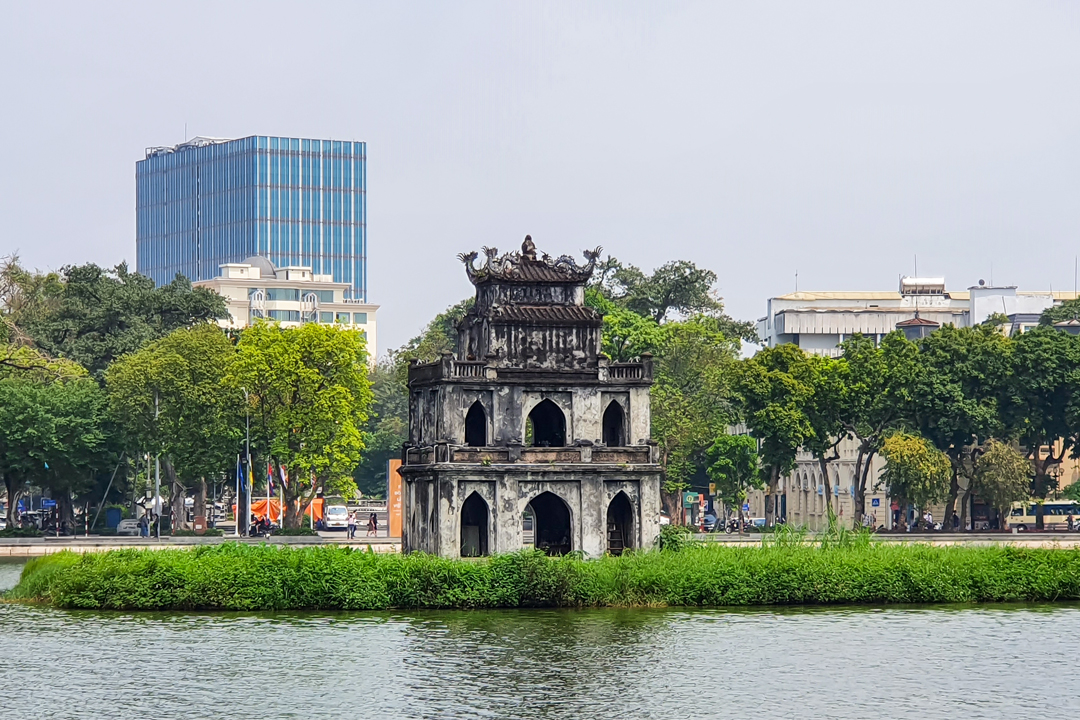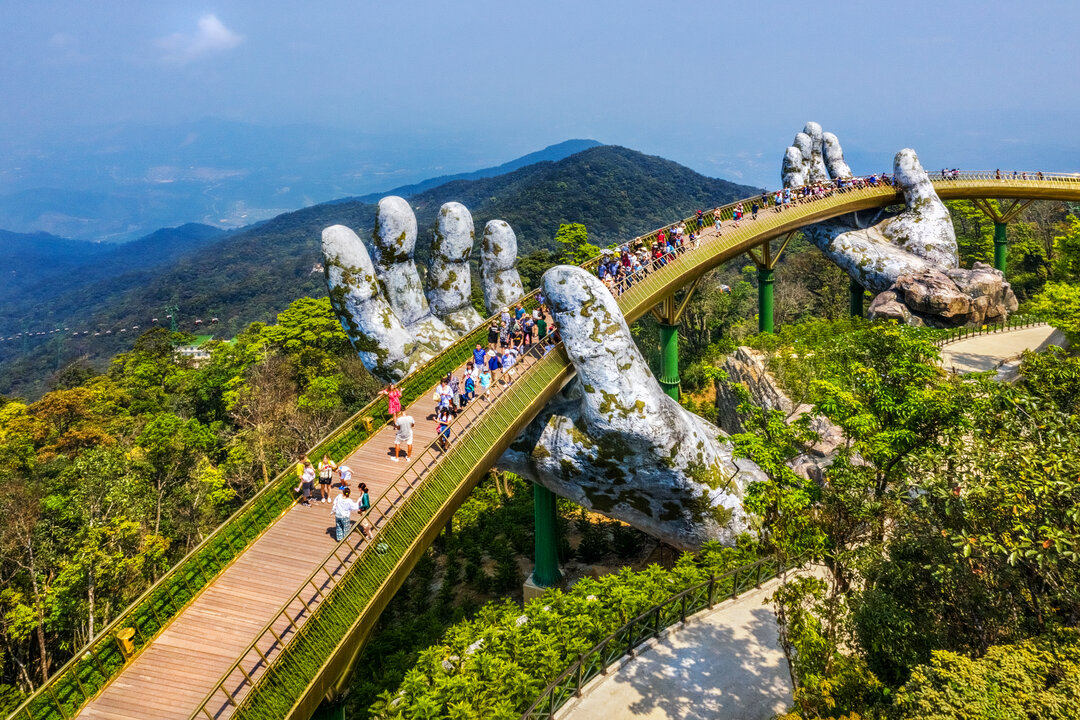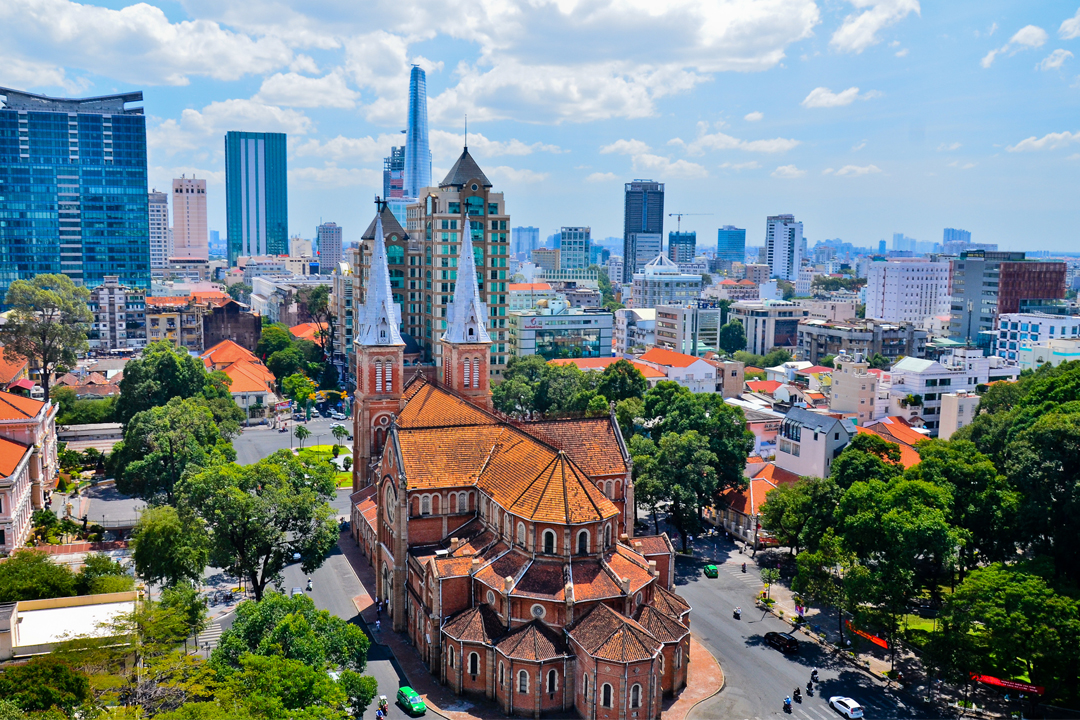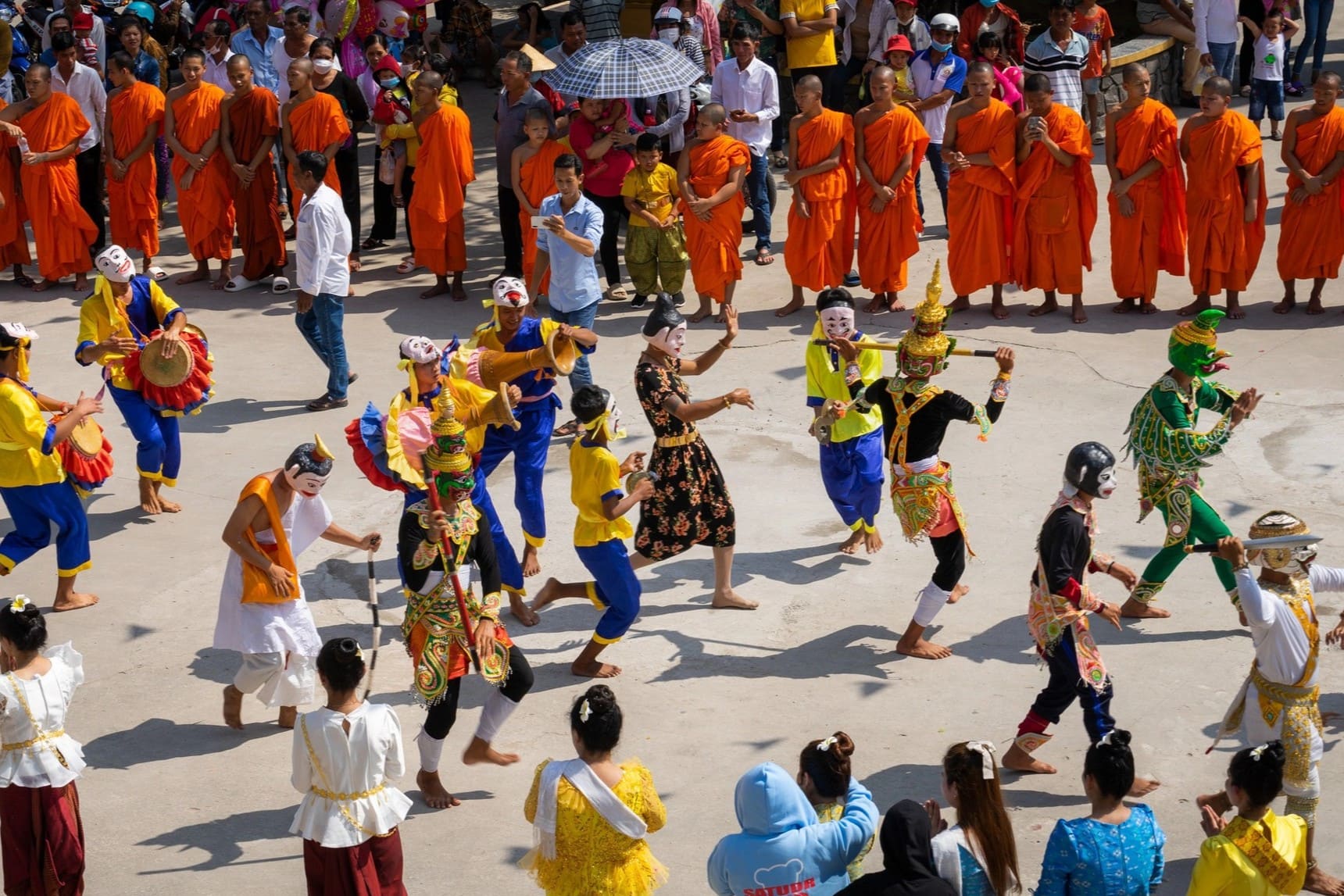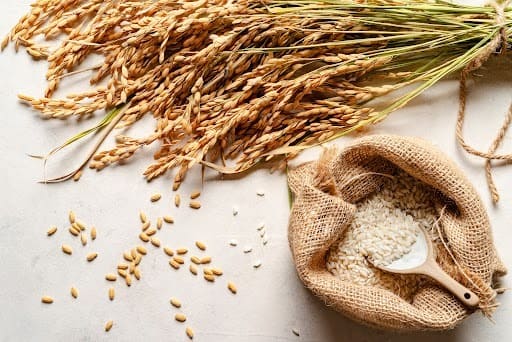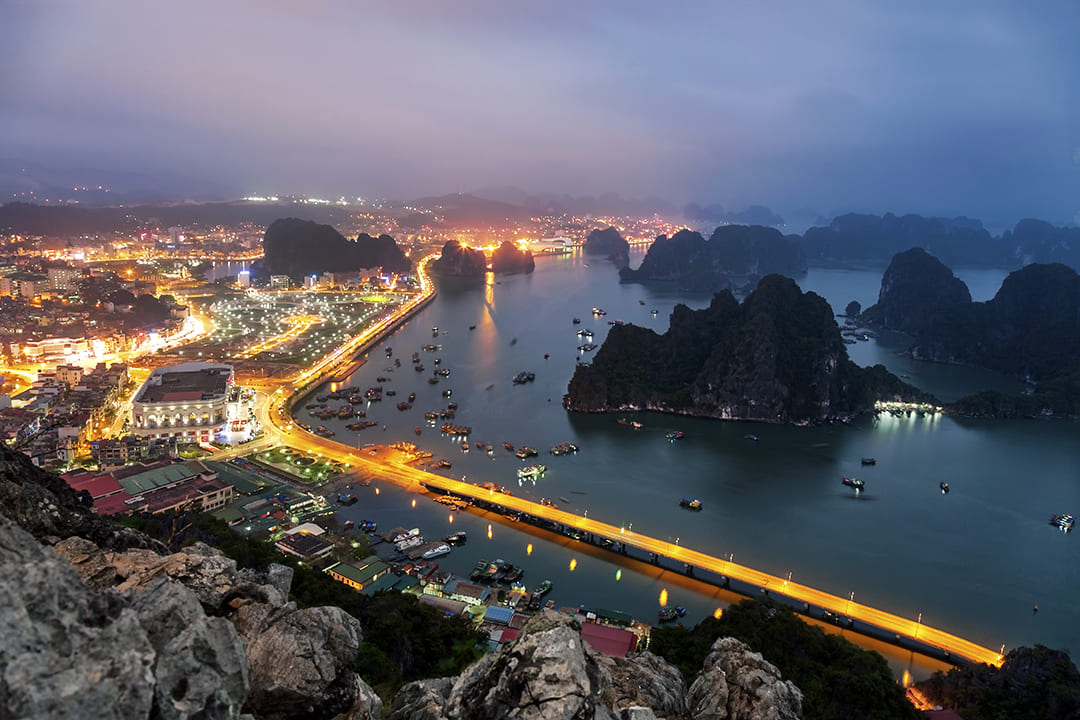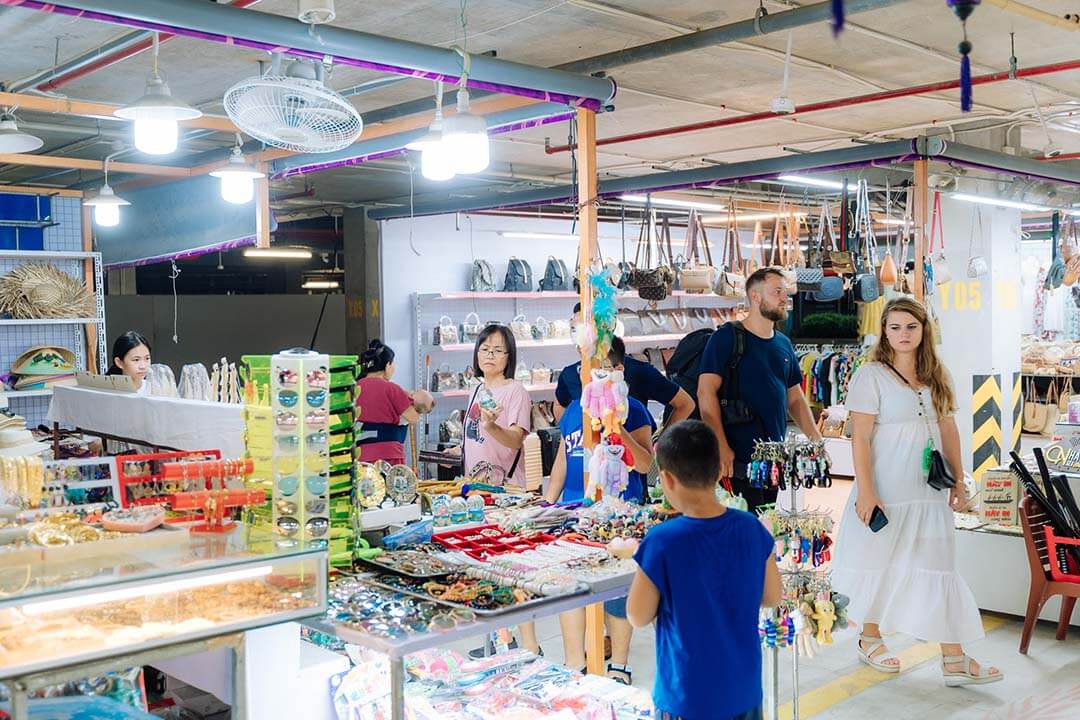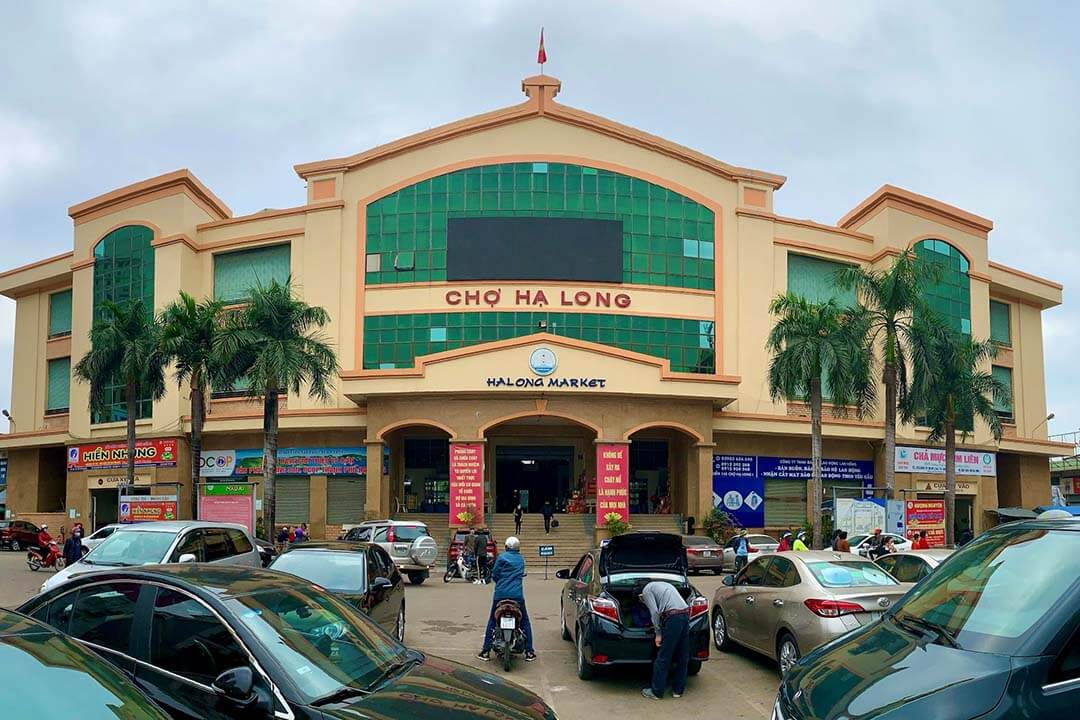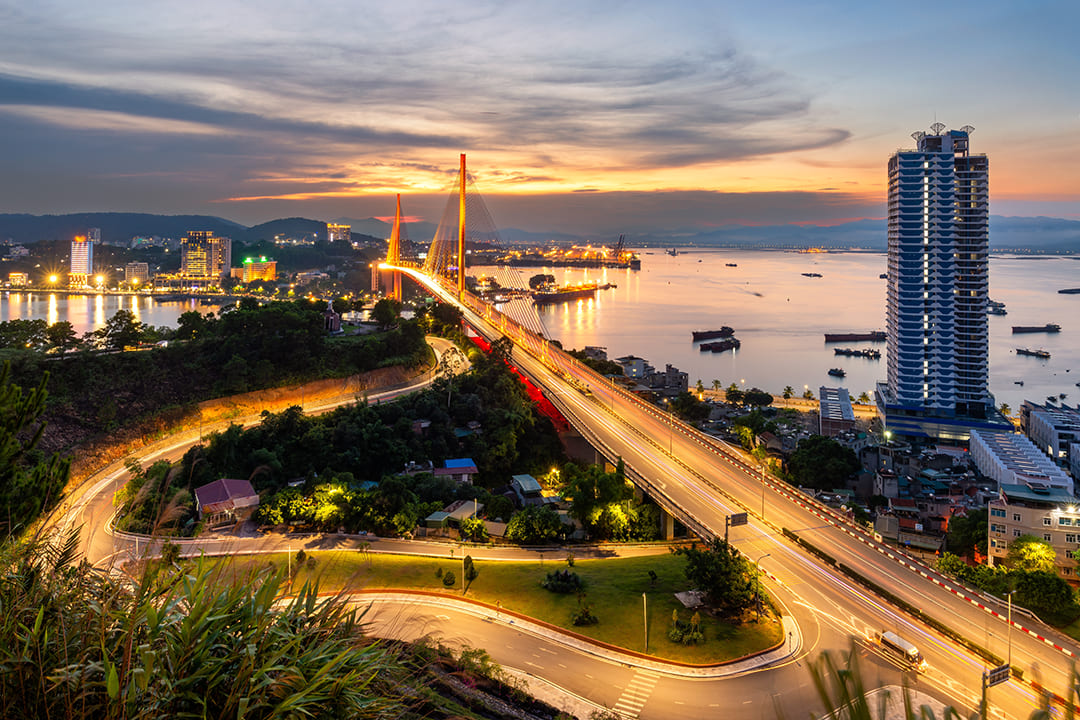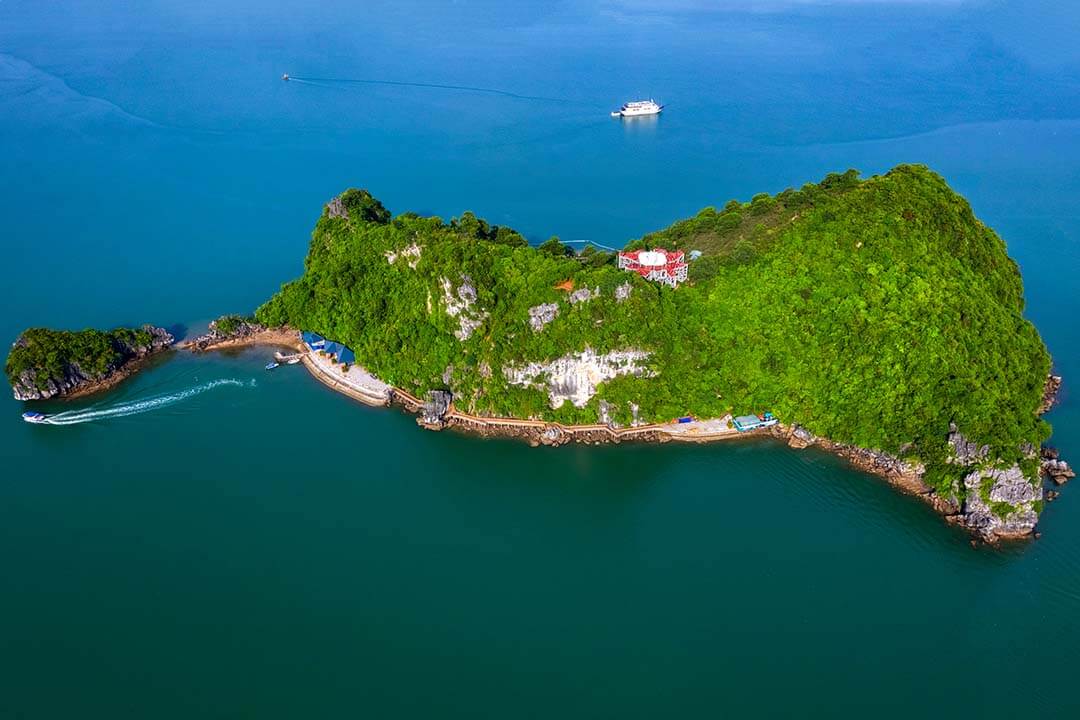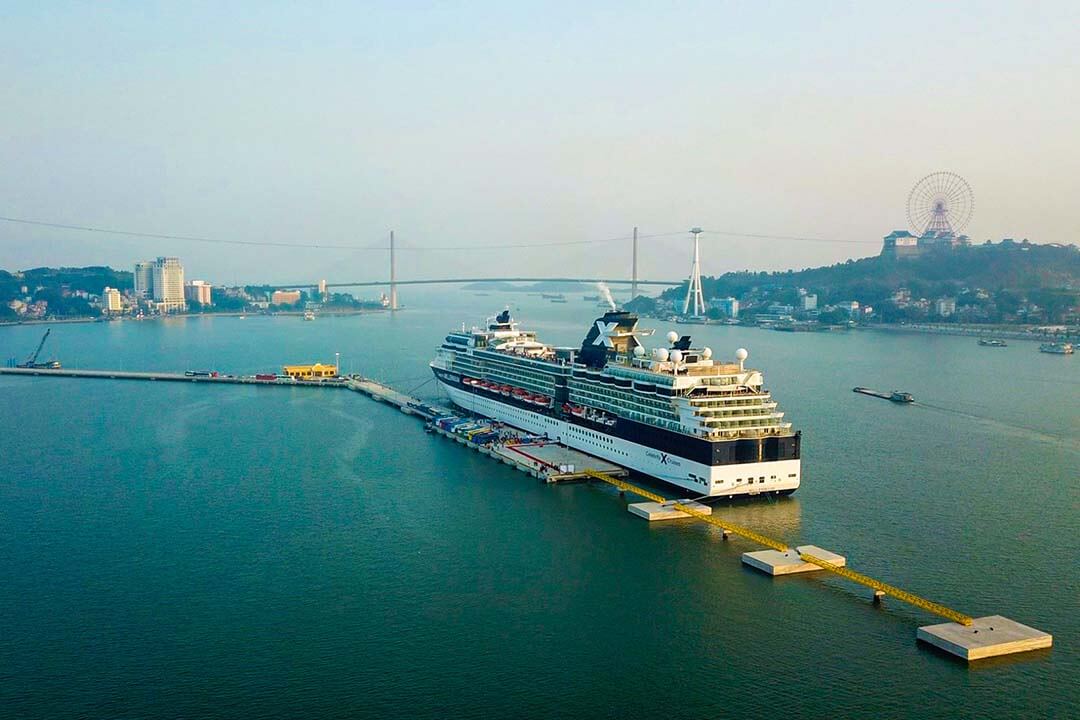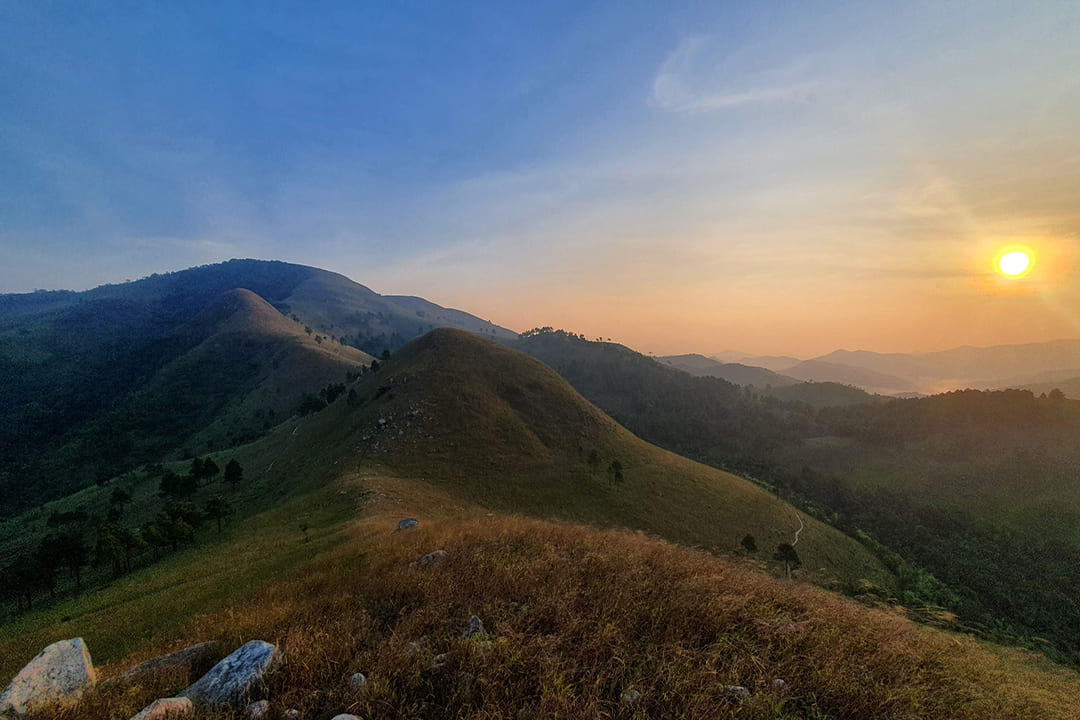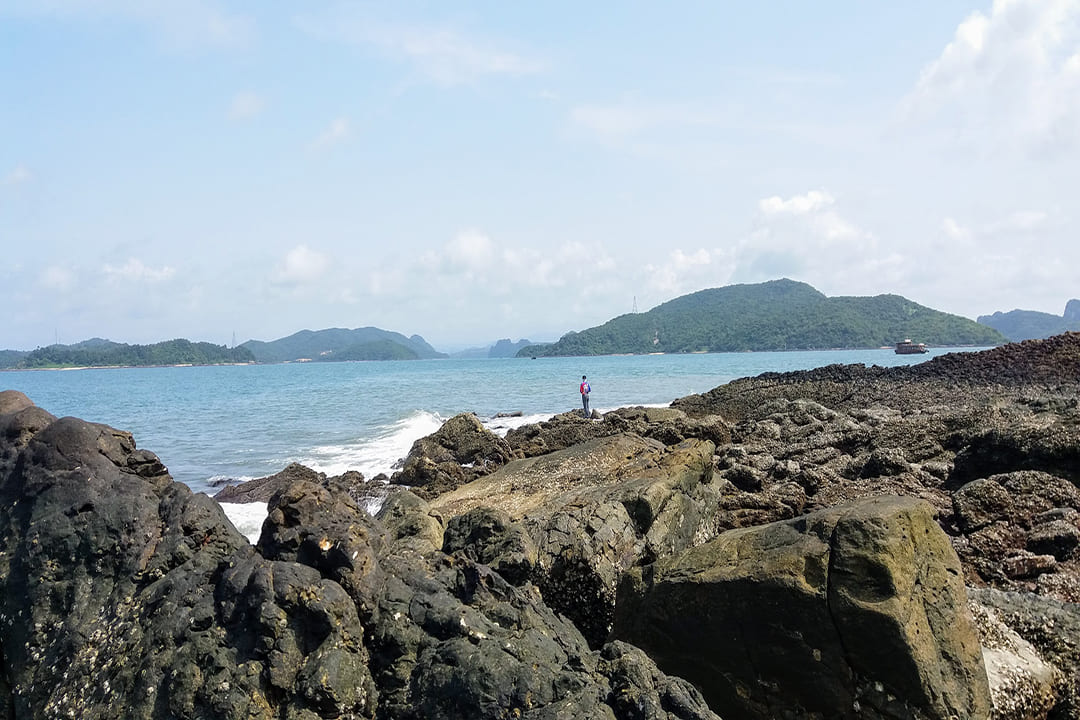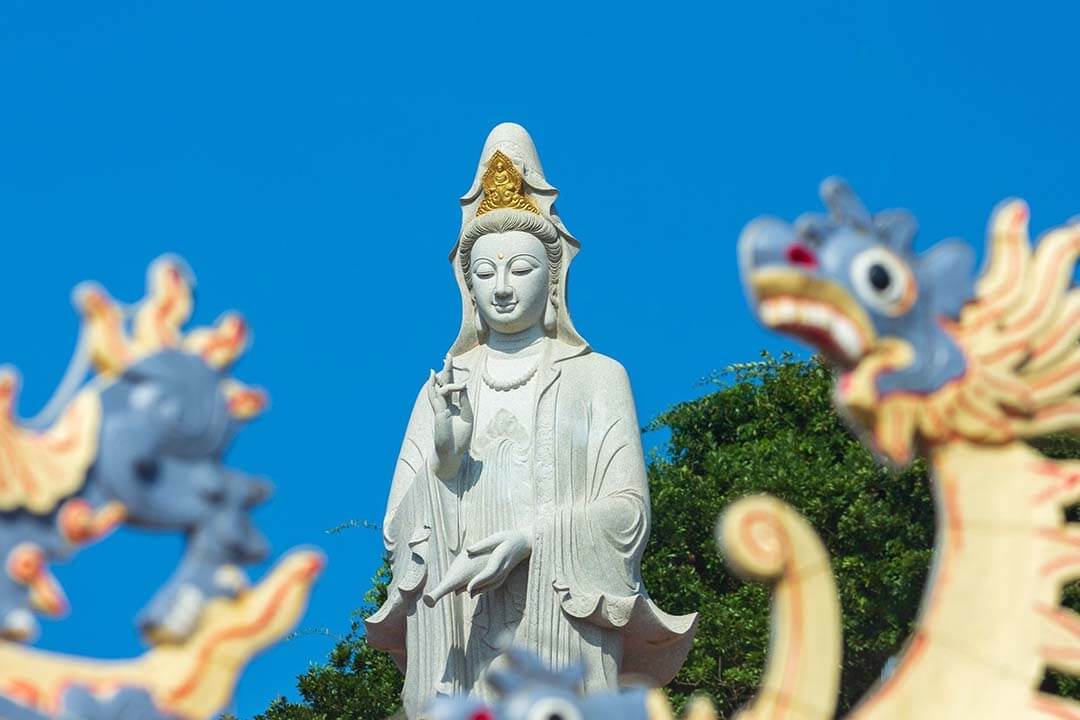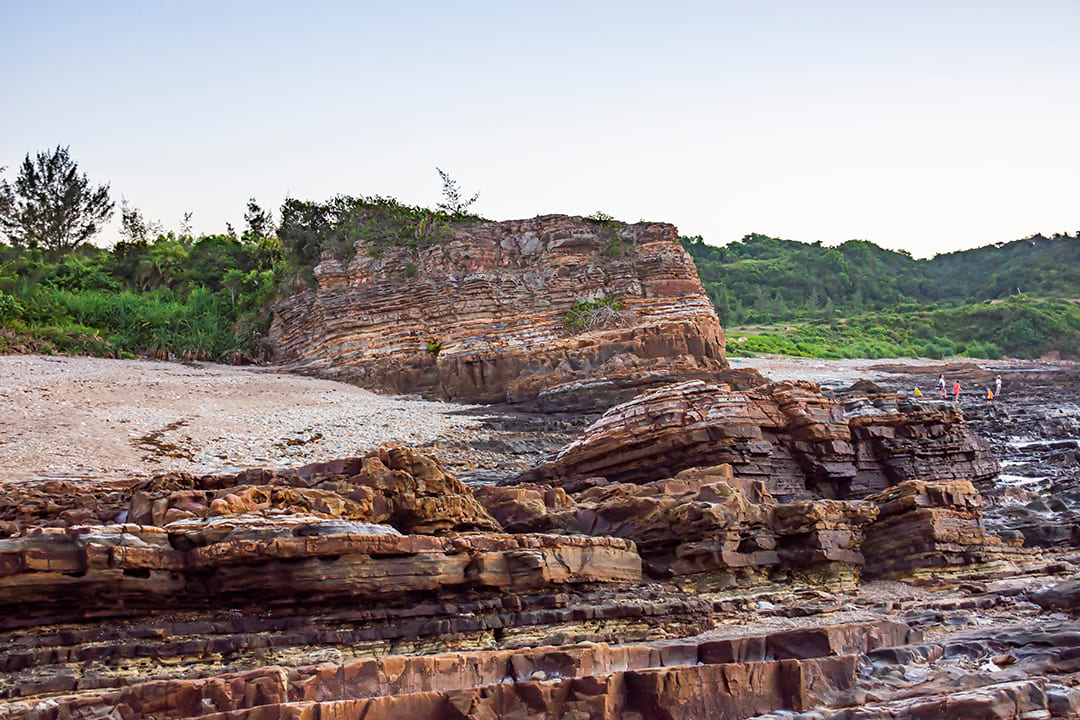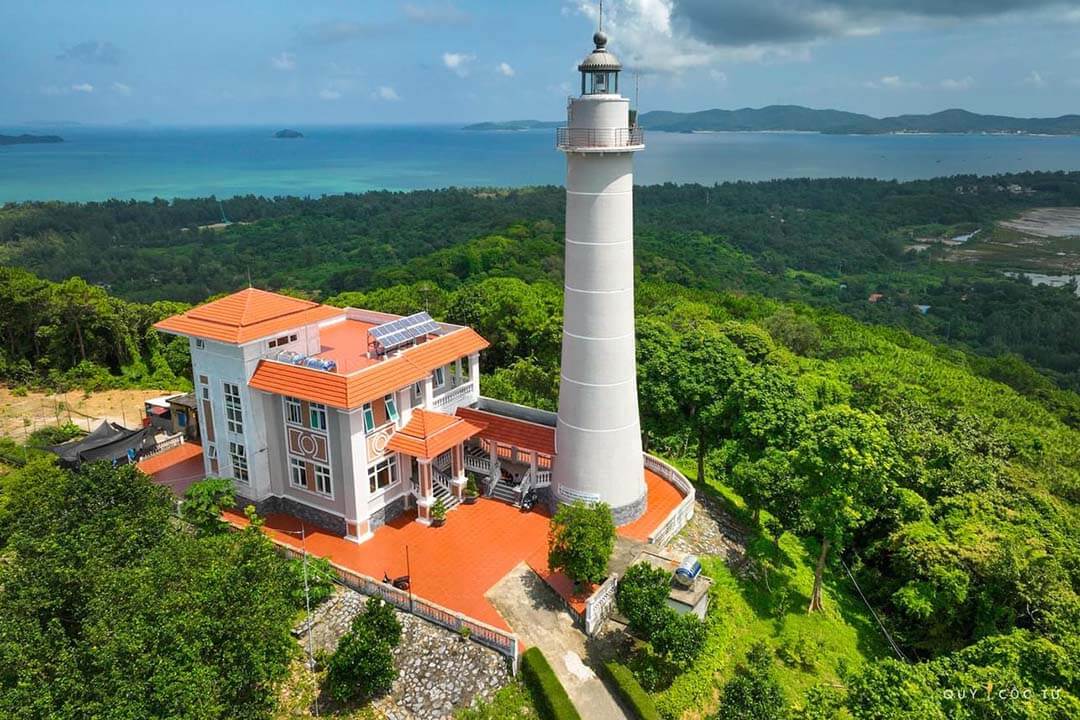Dec - 06 - 2024
Ba Vang Pagoda, located on Thanh Dang Mountain in Uong Bi, Quang Ninh Province, offers people a tranquil escape into Vietnam’s spiritual heritage. Perched 340 meters above sea level, the pagoda presents breathtaking views of the surrounding mountains and valleys. The distant view of the historic Bach Dang River also adds a layer of cultural significance, connecting the pagoda to Vietnam's storied past.
The pagoda’s architecture showcases a blend of traditional Vietnamese design and Buddhist symbolism. Ba Vang features grand gates, a large prayer hall, and carefully crafted statues that highlight the craftsmanship and spirituality of the region. It also boasts the largest Buddhist hall on a mountain in Indochina and includes a unique bell and drum tower, each integral to its spiritual and cultural identity.
Tourists to this pagoda can experience a variety of traditional and spiritual activities. With its rich history, scenic beauty, and unique architectural elements, the pagoda provides an enriching experience for those exploring northern Vietnam. Let’s join GTrip to discover Ba Vang Pagoda specialness, things to do here and how to get to this pagoda. Book a Ha Long Bay tour of GTrip to explore this pagoda and nearby attractions.
What makes Ba Vang Pagoda unique?
The pagoda stands out among Vietnam’s temples for its unique combination of architectural style, spiritual aura, and cultural richness.
The rich historical background
Ba Vang Pagoda has a rich historical background that dates back to 1706, during the reign of King Le Du Tong of the Le Dynasty. Originally named Bao Quang Tu, the pagoda was established as a place of worship and spiritual learning. However, like many ancient structures, the pagoda has witnessed periods of decay due to natural disasters and conflicts. These events led to the loss of several original relics and structures, leaving behind only a few artifacts like the stone incense tree and spiritual stele. Despite these losses, the pagoda embodies resilience, standing as a testament to the community’s dedication to preserving its spiritual heritage.
Significant efforts to restore the pagoda began in 1988, with a more comprehensive rebuilding completed by 1993. These milestones marked a new phase in the pagoda's development, as it became a center for both local worship and tourism. The recent renovations, starting in 2011, expanded the pagoda to accommodate growing interest and the increasing number of people while promoting Buddhist practices. The pagoda’s facilities now include areas for Buddhist teachings, meditation, and cultural ceremonies, making it a hub for spiritual gatherings.
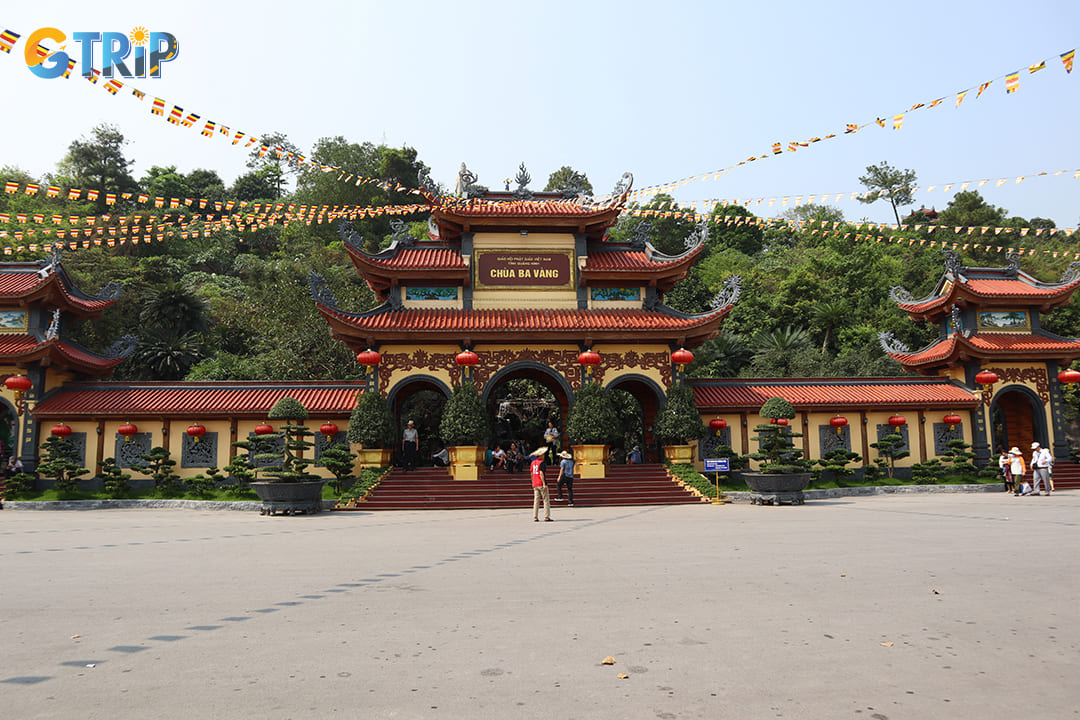
The gate of Ba Vang Pagoda
The pagoda holds an essential place in Vietnamese Buddhist culture, symbolizing a harmonious blend of historical legacy and contemporary relevance. The pagoda’s historical journey celebrates devotion to Buddhist figures such as Buddha, the Mother Goddess, and Ong, representing different aspects of Vietnamese spirituality. The evolution of Ba Vang highlights the resilience of Vietnamese Buddhist practices and the deep-seated cultural heritage that has been preserved here.
Legend of Ba Vang Pagoda
The legend of the pagoda is rooted in the mysterious origins of a sacred well that locals believe possesses divine qualities. This tale tells of a well that had remained dry for many years, but in 2007, the water miraculously returned. This marked a turning point in the pagoda’s history and signaled the beginning of its modern restoration. Known as the "godly well", it is shrouded in mystery and believed to offer healing properties, with a particular potency on New Year’s Eve. This myth has been passed down and is now a cherished part of the pagoda’s lore, drawing many believers who hope to experience its reputed blessings for health and well-being.
The story of the well is associated with the Venerable Thich Truc Thai Minh, the abbot who played a key role in the revival of Ba Vang. According to tradition, the sudden flow of water in the well is seen as a divine endorsement of his mission to restore the pagoda and promote Buddhist practices in the region. This myth adds a layer of sacred significance to the site, intertwining the pagoda’s physical restoration with its spiritual rebirth. The godly well at Ba Vang Pagoda symbolizes faith and resilience, representing the strong link between religious belief and the mystical stories of this sacred site.
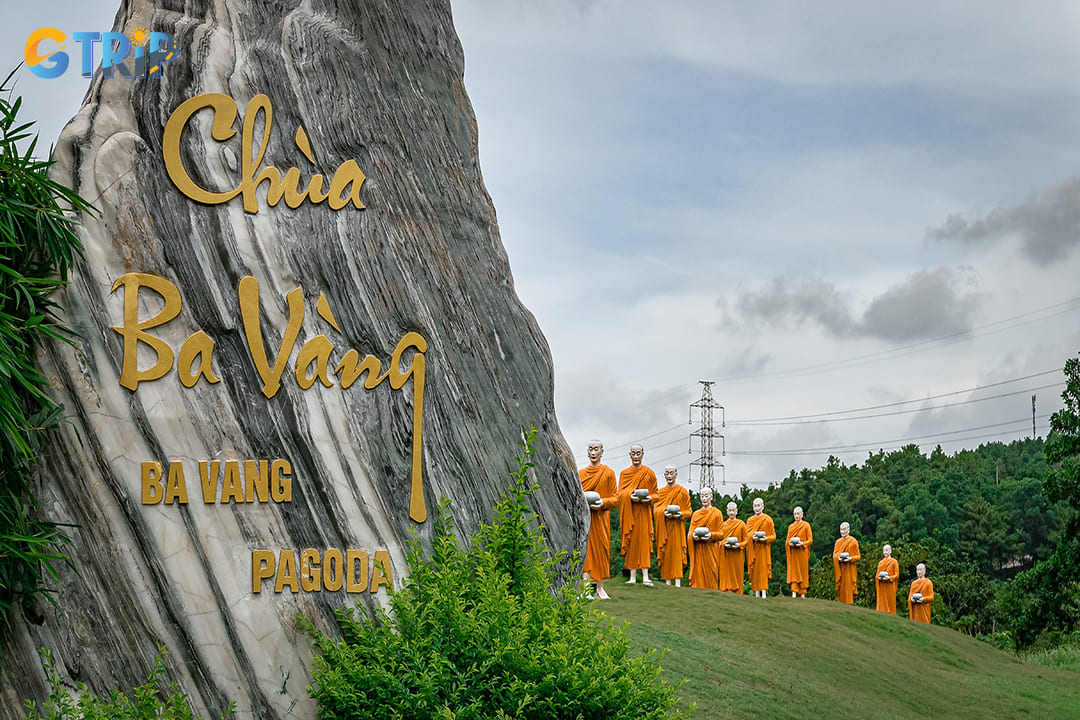
The legend of the pagoda is rooted in the mysterious origins of a sacred well
Impressive architectural features
Ba Vang Pagoda is a striking example of Vietnamese Buddhist architecture, blending grandeur with spiritual symbolism to create a visually and spiritually captivating environment. The pagoda's main hall, known as Dai Hung Bao Dien, is the largest Buddhist hall on a mountain in Indochina, and it stands out for its impressive scale and intricate design. The hall’s vast interior is a showcase of architectural craftsmanship, with towering ceilings and expansive spaces designed to accommodate large groups for worship and spiritual practices. Within this grand hall, you can find exquisite statues, including the Quan The Am Bodhisattva, symbolizing compassion, and the Buddha’s Birth Statue. The lifelike expressions and graceful postures of these statues add to the spiritual atmosphere, inviting you to pause and reflect.
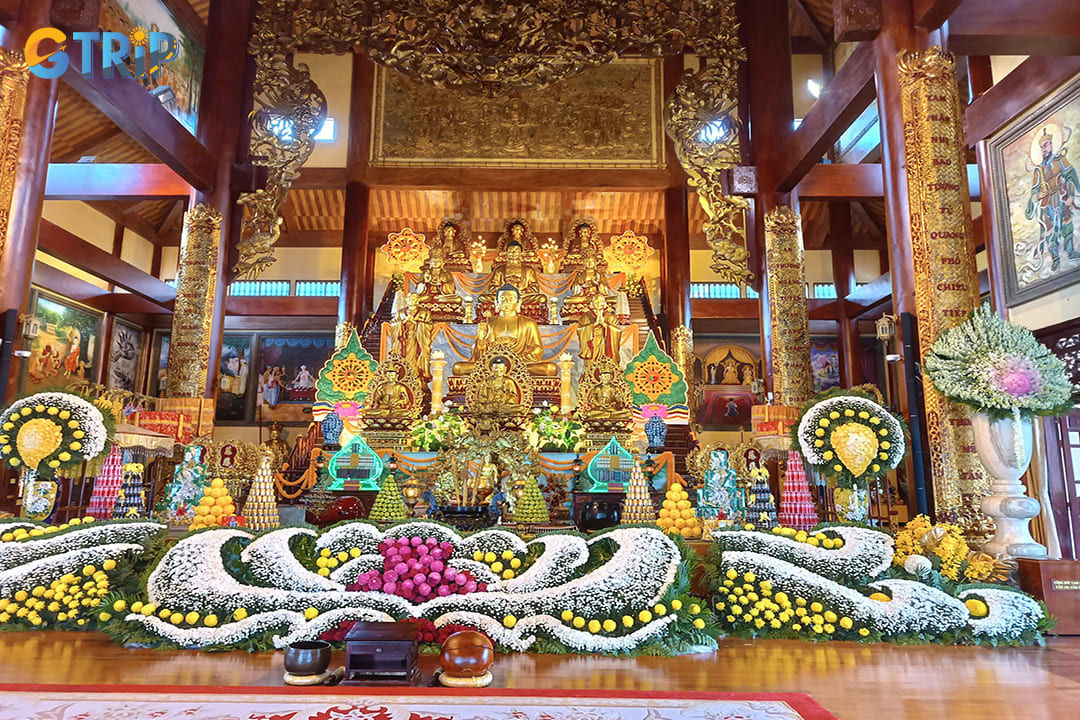
The statues in the main hall of the pagoda
The pagoda is also known for its Tam Quan Noi Gate, a majestic three-tiered structure that marks the entrance to the sacred grounds. This gate stands out for its combination of traditional architectural design and symbolic carvings, featuring dragons, phoenixes, and lotus flowers. The grandeur of the gate sets the tone for the entire pagoda, welcoming people to a place of peace and spiritual reflection. The One Pillar Pagoda and Crescent Lake further enhance the site’s aesthetic, providing serene spaces for contemplation while symbolizing Buddhist principles of harmony and balance. The Crescent Lake, in particular, mirrors the natural surroundings, reinforcing the pagoda’s seamless integration with its environment.
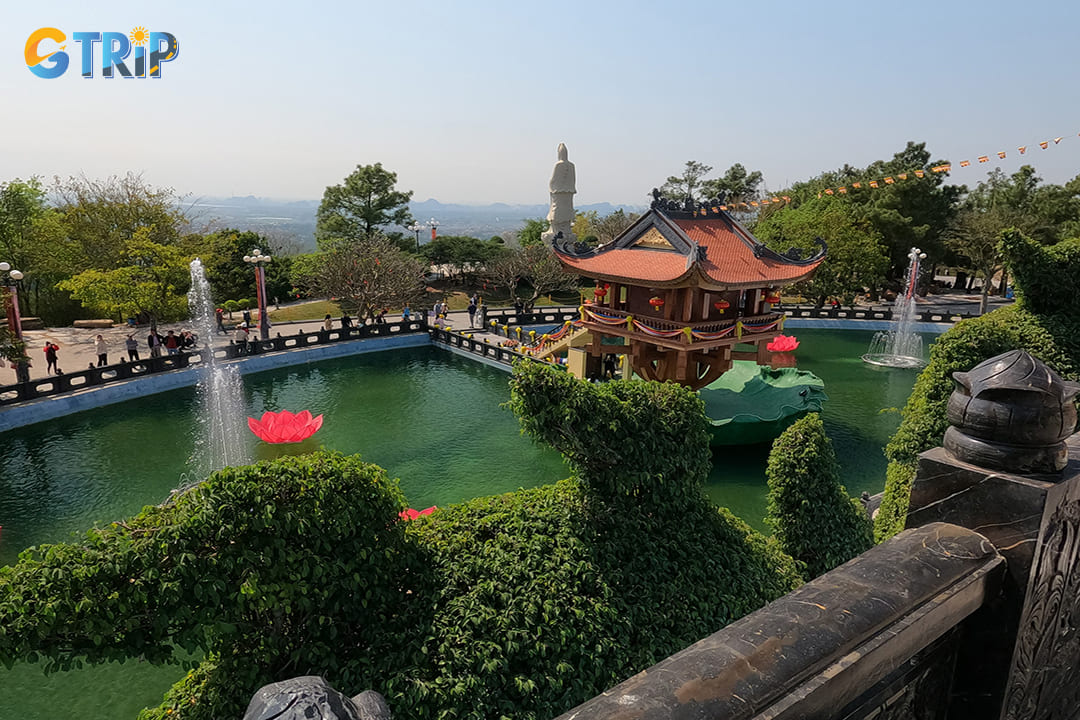
The One Pillar Pagoda and Crescent Lake of the Pagoda
Ba Vang Pagoda’s grounds include the Eighteen Arhats Corridor, which highlights a series of statues representing Buddhist disciples who achieved enlightenment. These statues are displayed along the corridor in meticulous detail, each one capturing a moment of spiritual attainment. People walking along the path are not only treated to beautiful sculptures but also encouraged to reflect on the spiritual journey toward enlightenment. The Godly Well, believed to have healing powers, is another notable feature of the pagoda. This well has been a central part of local lore and spiritual belief, with many seeking its water for physical and spiritual rejuvenation, adding a unique dimension to the pagoda’s architecture.
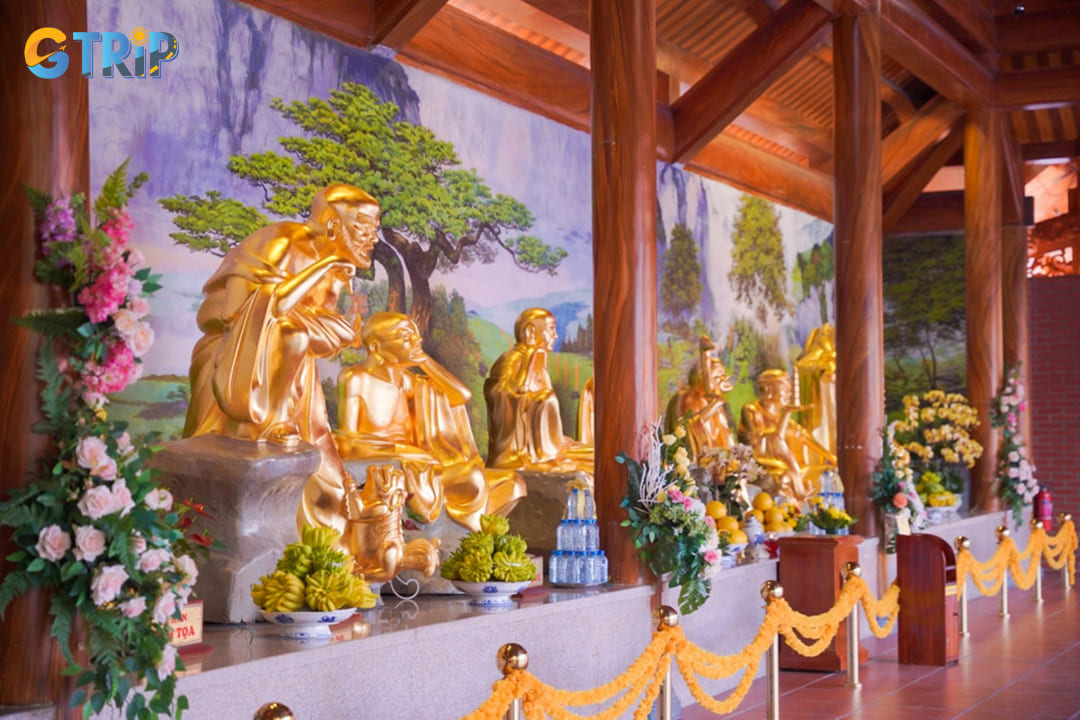
The Eighteen Arhats Corridor with a series of statues
Throughout the entire structure, the craftsmanship of the carvings, sculptures, and statues reflects the deep-rooted tradition of Vietnamese Buddhist art. The pagoda’s Buddhist design, with its symmetrical structure and natural materials like wood and stone, harmonizes beautifully with the surrounding landscape and offers breathtaking views of Ha Long Bay. Each corner offers a new facet of its beauty, with traditional architectural principles that have been carefully preserved and enriched over time. The pagoda’s aesthetic appeal, combined with its rich spiritual symbolism, makes it one of the most iconic and revered landmarks in northern Vietnam.
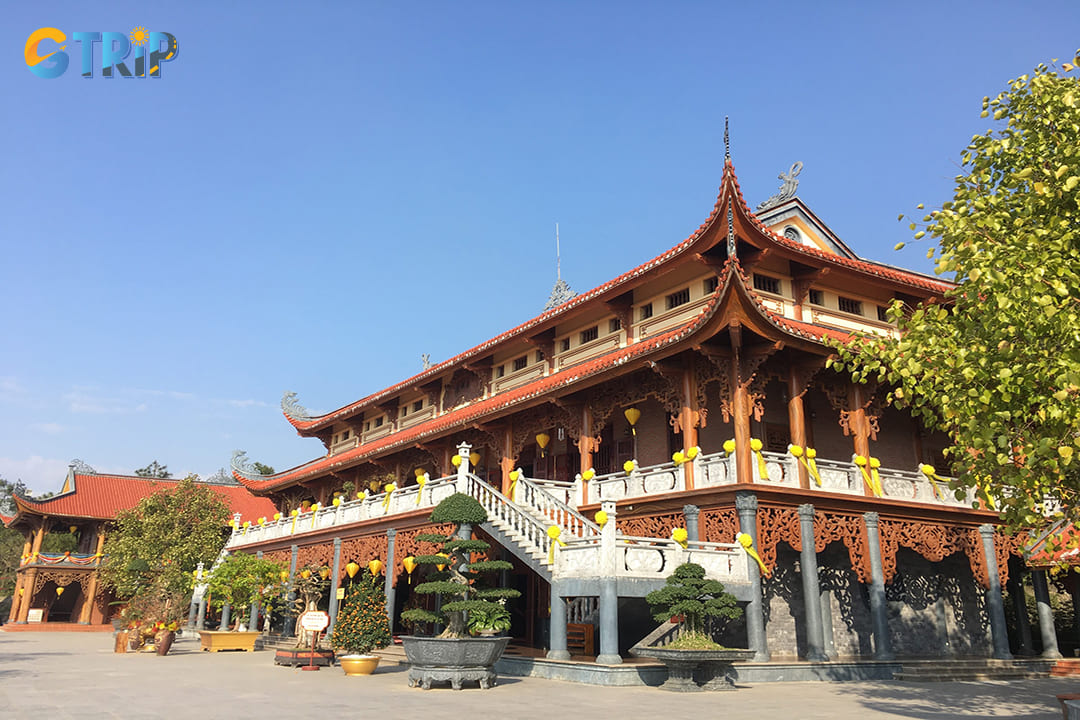
The pagoda’s Buddhist design features a symmetrical structure and natural materials
7 things to do in Ba Vang Pagoda
There is an array of activities and experiences for travelers to explore and admire. People can fully immerse themselves in the unique spiritual and cultural heritage of this revered site.
Admire the Main Hall
At Ba Vang, the Main Hall, also known as Dai Hung Bao Dien, is an architectural marvel and a focal point of spiritual activity. As the largest Buddhist hall on a mountain in Indochina, this hall showcases intricate wood carvings, vibrant murals, and statues that represent key moments in the Buddha's life. You can marvel at the spacious hall’s exquisite decor, observing delicate floral patterns and vibrant colors that fill the room with a warm and reverent atmosphere. The hall’s ambiance, combined with its grandeur, creates a sense of awe and peace, inviting guests to sit in quiet reflection or participate in Buddhist practices.
The Main Hall also features iconic statues, such as the Quan The Am Bodhisattva and the Buddha’s Birth Statue. These statues are beautifully crafted and embody both religious significance and artistry, with the Bodhisattva statue standing as one of the largest solid stone statues in Vietnam. Every detail, from the facial expressions to the flowing robes, is carefully sculpted, demonstrating the craftsmanship that brings these spiritual figures to life. People are encouraged to explore the hall’s intricate artwork, which symbolizes Buddhist teachings and reflects the depth of Vietnamese Buddhist culture.
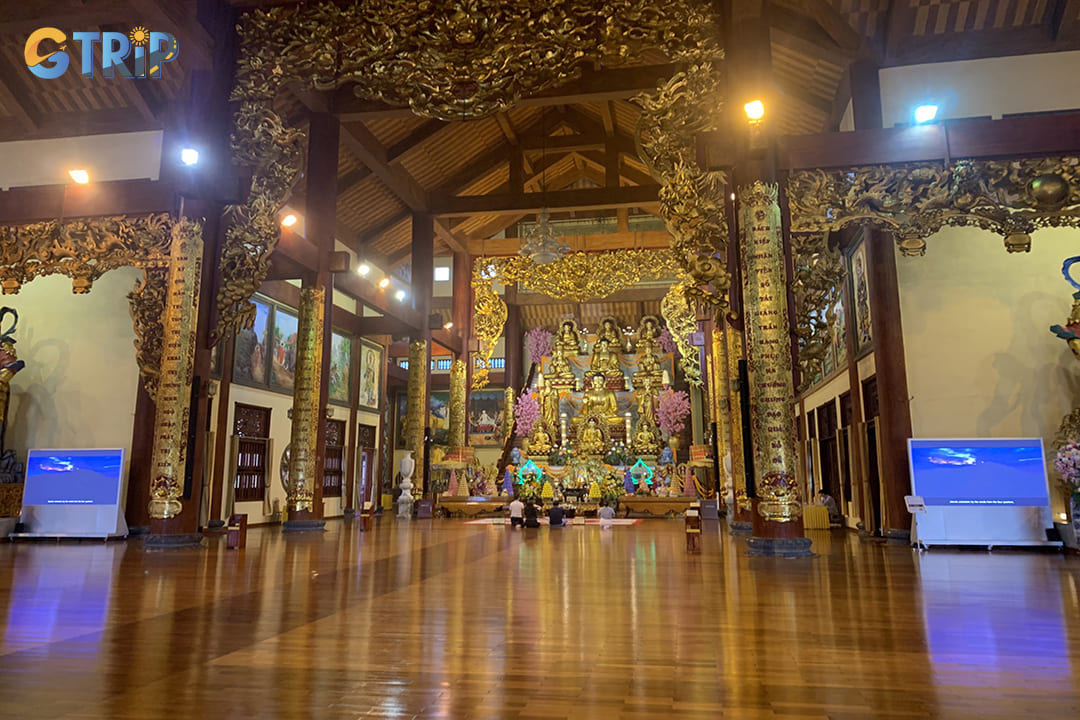
People are praying at the Main Hall
Experience religious practice
Ba Vang Pagoda offers you the chance to experience authentic Buddhist rituals, from daily prayers to elaborate ceremonies. Participating in or simply observing these practices allows guests to gain insight into Vietnamese Buddhism and its traditions. The pagoda hosts a range of spiritual activities, including incense offerings, meditation sessions, and blessings led by resident monks. Guests can join in these practices, offering incense as a gesture of respect and partaking in chants that create a tranquil and harmonious atmosphere throughout the temple grounds.
The religious practices at Ba Vang Pagoda are rooted in Mahayana Buddhism, which emphasizes compassion, mindfulness, and inner peace. Meditation sessions are particularly popular, as they offer people a moment of calm to reconnect with themselves. These practices are more than rituals - they’re immersive experiences that allow guests to reflect on Buddhist teachings. Observing monks in prayer and joining in blessings provides a meaningful connection to the spiritual heritage of Vietnam, making the visit both culturally and personally enriching.
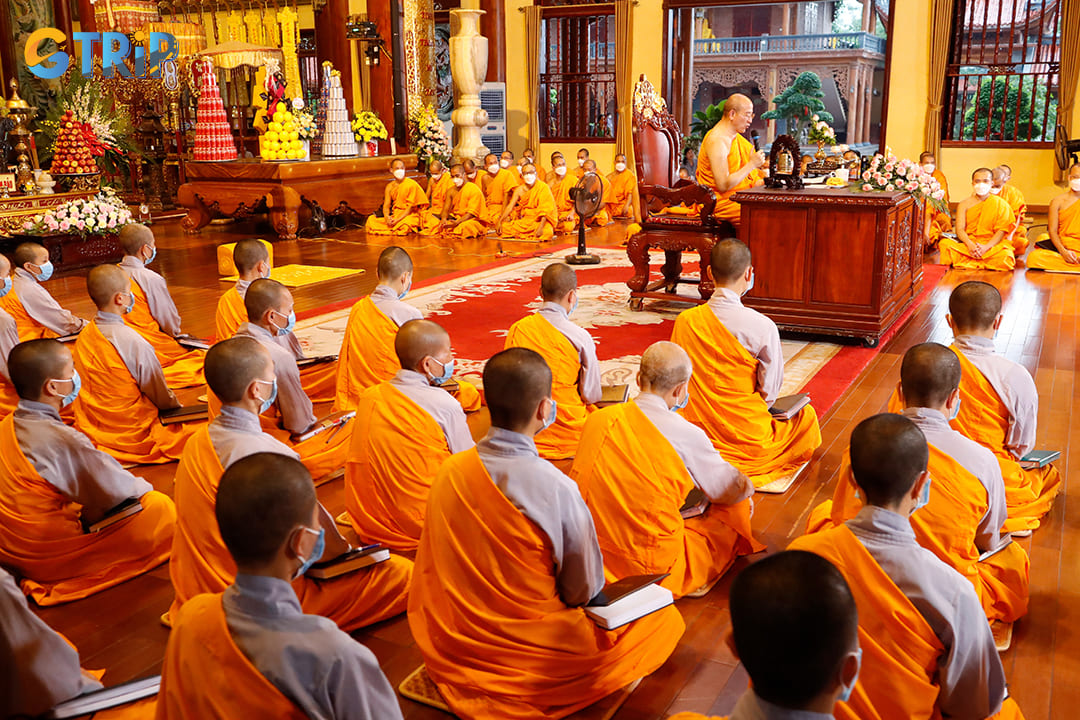
Tourists have a chance to observe monks in prayer and join in blessings
Walk through the Eighteen Arhats Corridor
One of the highlights of the pagoda is the Eighteen Arhats Corridor, a serene pathway lined with statues of Buddhist disciples known as Arhats. Walking through this corridor, you encounter each of the Eighteen Arhats, whose statues capture various expressions of enlightenment and compassion. The journey along this corridor symbolizes the spiritual journey toward enlightenment, offering guests a space to reflect on the virtues and teachings of Buddhism.
Each statue along the corridor is meticulously crafted, with unique features that convey the Arhats’ wisdom and devotion. The path encourages contemplation and inspires inner peace, making it a meaningful experience for those seeking to connect with Buddhist philosophy. As you walk through this symbolic path, they are invited to appreciate the artistic craftsmanship and the profound spiritual messages embodied in each statue.
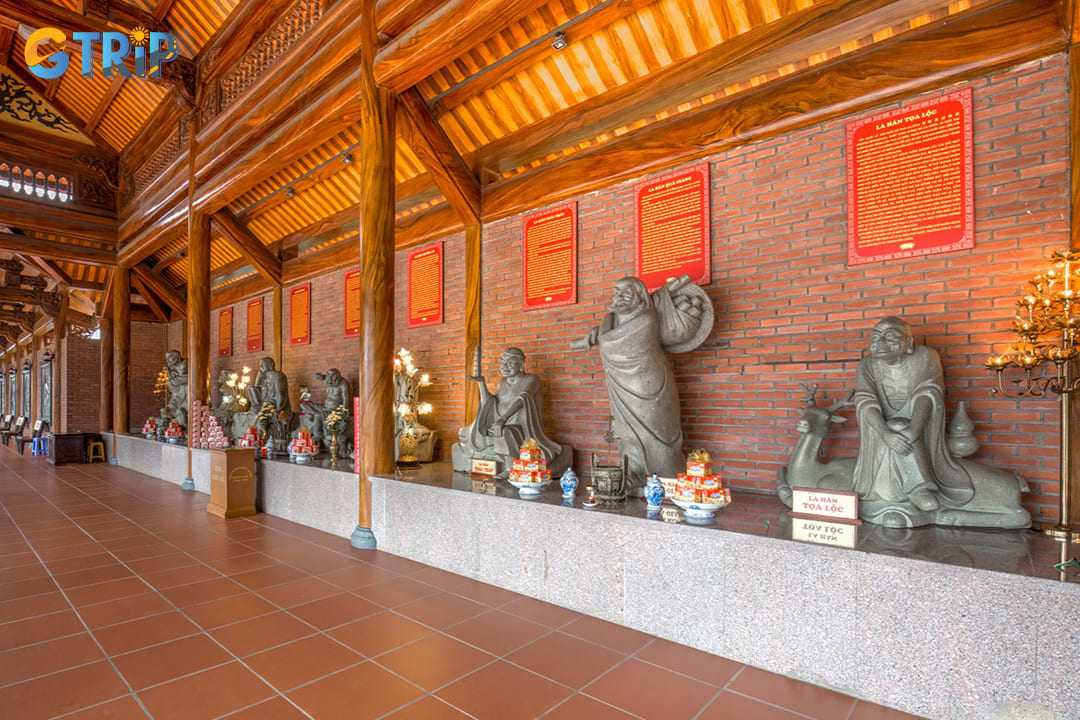
The corridor lined with statues of Buddhist disciples known as Arhats
Drink from the Godly Well
Ba Vang Pagoda is home to the Godly Well, a revered source of water believed to have healing properties. According to local lore, this well had been dry for years before water miraculously began flowing again in 2007, which many see as a divine sign. People often come to this well to drink its water or collect it, especially around the New Year, as it is believed to bring health and good fortune for the coming year.
Many people drink from the well as part of a traditional ritual, viewing the water as a blessing from higher powers. This ancient well embodies the intersection of myth and faith, allowing you to participate in a centuries-old tradition that reinforces the spiritual significance of Ba Vang.
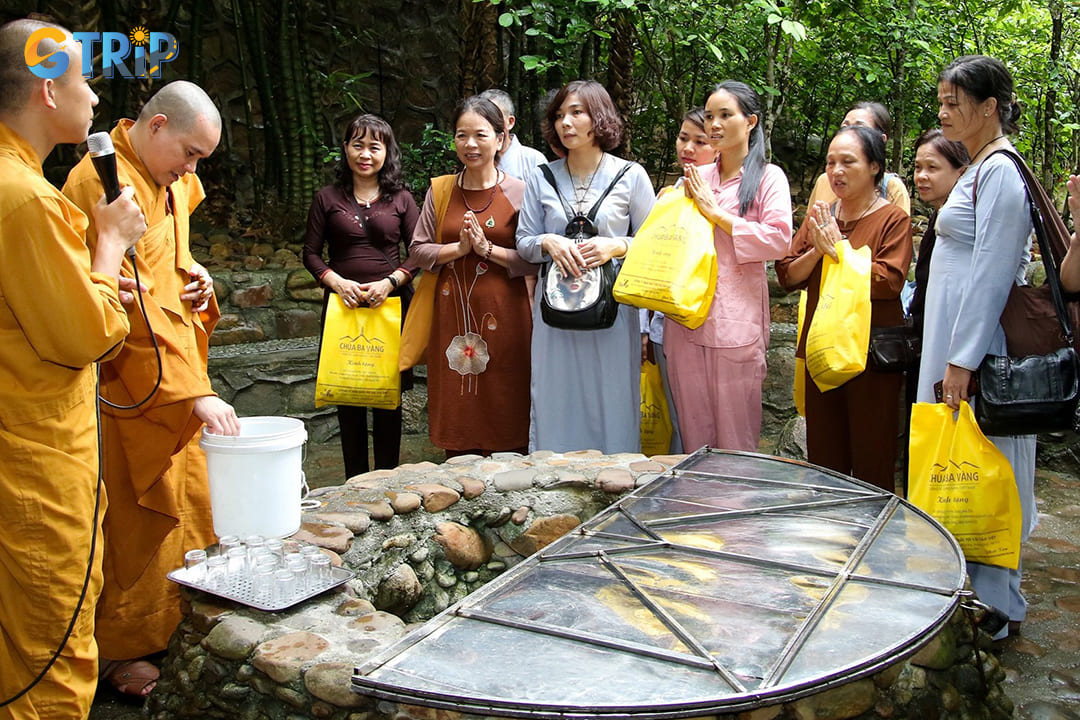
Tourists are visiting the Godly Well in the pagoda
Hike to the top of Bo De Mountain
For those seeking both spiritual and physical challenge, a hike up Bo De Mountain offers a rewarding experience with panoramic views of the surrounding landscape. The ascent provides an opportunity to explore the natural beauty of the area, passing by smaller temples and shrines along the way that add to the spiritual journey. At the summit, people are greeted by the sight of a Bodhi Tree and the Great Stupa, both symbols of enlightenment and Buddhist devotion.
The climb to the peak of Bo De Mountain is not only a test of endurance but also a chance to connect with nature and spirituality. Surrounded by lush greenery and scenic views, the mountain creates a sense of peace and solitude. This journey allows guests to appreciate the natural landscape that frames Ba Vang Pagoda, as well as to engage in quiet reflection at the summit, which holds cultural and spiritual significance.
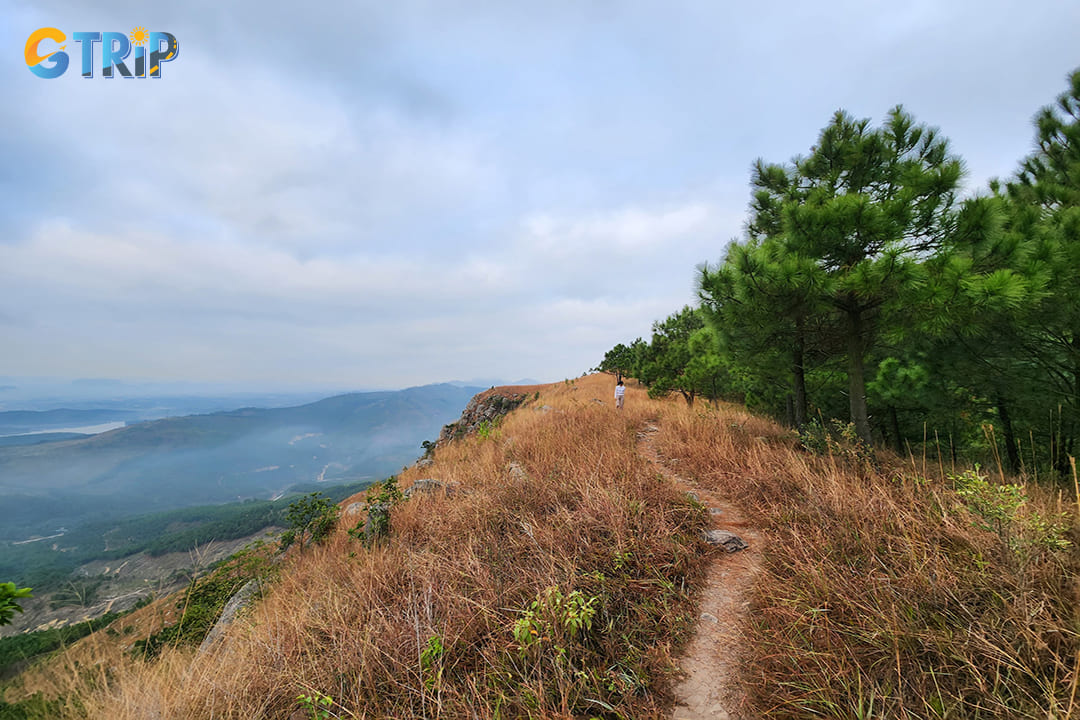
Hike to the top of Bo De Mountain to see panoramic views of the surrounding landscape
Explore the One Pillar at Ba Vang Pagoda
Another must-see landmark is the One Pillar Pagoda, a structure that reflects traditional Vietnamese architecture and spiritual significance. This unique structure is modeled after the famous One Pillar Pagoda in Hanoi but holds distinct significance within the context of Ba Vang. Its single pillar symbolizes purity, strength, and faith, and it serves as a focal point for prayer and meditation.
You can marvel at the One Pillar Pagoda’s design, observing how the simplicity of its structure contrasts beautifully with the natural surroundings. This spot is popular for meditation, as it provides a quiet, secluded space for reflection. The One Pillar Pagoda embodies the pagoda’s spiritual essence, emphasizing values like humility and mindfulness, which resonate deeply with both local pilgrims and international tourists alike.
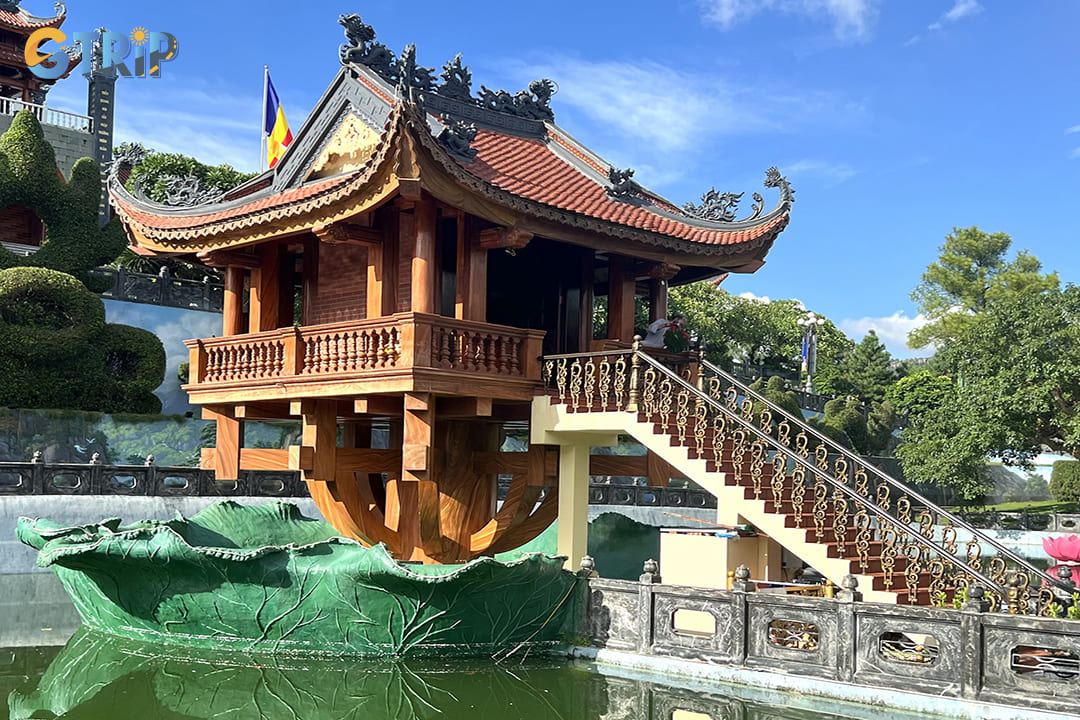
The One Pillar Pagoda holds distinct significance within the context of Ba Vang
Participate in famous festivals
Ba Vang Pagoda’s festivals are rich in cultural heritage and spiritual significance, drawing crowds who come to witness and participate in these annual celebrations. The Spring Festival, celebrated on the 8th day of the first lunar month, is one of the largest and most vibrant events at the pagoda. Marking the start of the Lunar New Year, the festival includes elaborate rituals to honor Buddha and seek blessings for prosperity, health, and peace in the coming year. Traditional music fills the air as monks lead chanting ceremonies, while devotees offer incense and flowers at various altars. The atmosphere is alive with cultural performances, including dragon dances and folk music, that bring the community together in a joyful and reflective celebration of new beginnings.
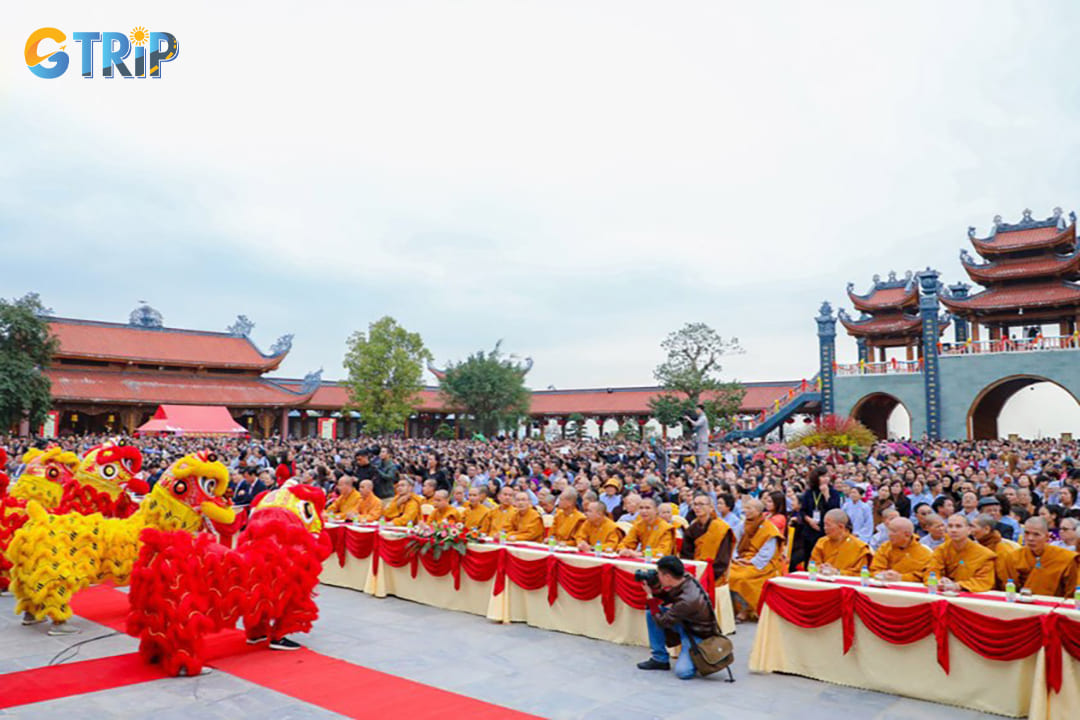
The atmosphere of the Spring Festival at the start of Lunar New Year
Another central festival at Ba Vang Pagoda is Buddha’s Birthday, held on the 8th day of the fourth lunar month, which commemorates the birth of the historical Buddha. This festival is a peaceful yet profound gathering, focusing on expressions of gratitude and respect toward Buddha’s teachings. During this event, people participate in rituals such as bathing the Buddha statue, which symbolizes the purification of one’s mind and soul. The pagoda grounds are adorned with colorful decorations, and monks lead devotees in prayers and meditations to reflect on Buddha’s life and his path to enlightenment. This celebration allows participants to reconnect with Buddhist values of compassion and mindfulness, making it a meaningful experience for both locals and tourists.
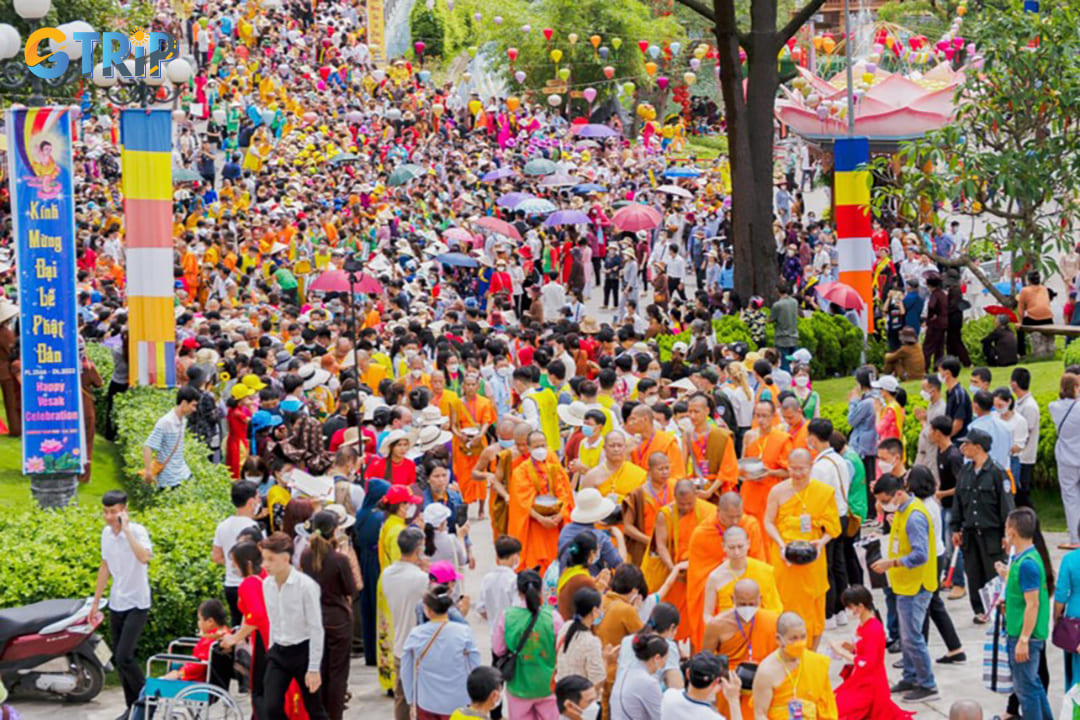
The festival’s celebration allows participants to reconnect with Buddhist values of compassion and mindfulness
The Ullambana Festival, or "Ancestor Worship Festival", takes place in the seventh lunar month and emphasizes the importance of filial piety and honoring the deceased. This festival holds deep spiritual and familial importance, with rituals where families offer prayers and make offerings of food, incense, and other items to honor their ancestors. The pagoda’s monks lead solemn ceremonies, reciting chants to bless the souls of the departed and bring comfort to their descendants. For many, this festival is an emotional time to remember their roots and express gratitude to those who have come before them. It is a highly respected event in Vietnamese Buddhist tradition, bringing a sense of continuity between the past and present.
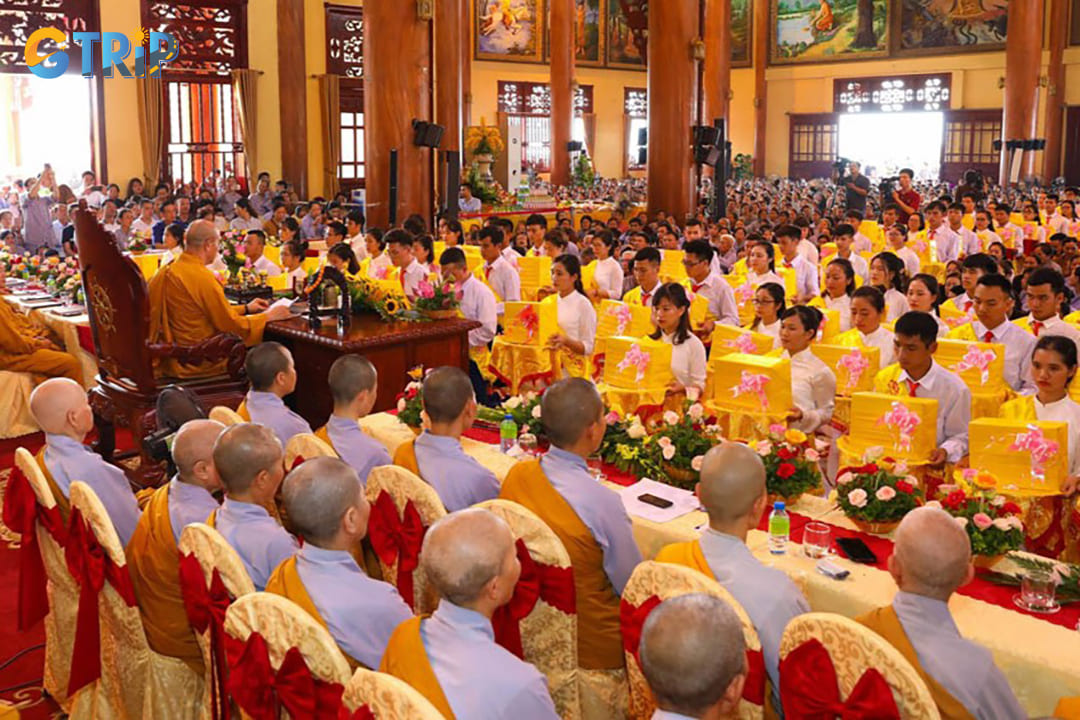
The Ullambana Festival holds deep spiritual and familial importance
The Chrysanthemum Festival, celebrated on the 9th day of the ninth lunar month, coincides with the Double Ninth Festival and is dedicated to themes of health, longevity, and protection. At Ba Vang Pagoda, this festival is marked by vibrant chrysanthemum displays, as the flower symbolizes longevity and resilience in Vietnamese culture. Ceremonies are held to pray for well-being and long life, and the festival often includes cultural performances and traditional dances that add to the festive atmosphere. The pagoda grounds become a showcase of colorful chrysanthemums, arranged in intricate patterns, attracting tourists who come to admire the floral displays and partake in the rituals. This festival provides an uplifting and visually beautiful experience, reinforcing values of health and vitality in a celebratory yet peaceful setting.
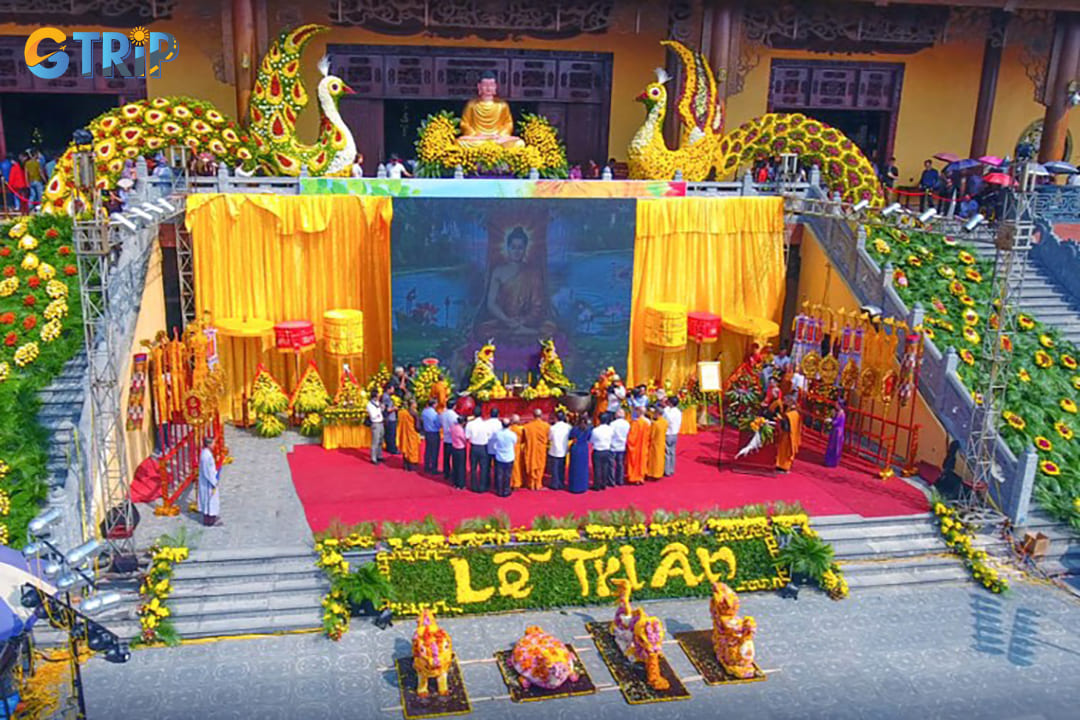
The Chrysanthemum Festival is dedicated to themes of health, longevity, and protection
When is the best time to visit Ba Vang Pagoda?
The ideal time to visit the pagoda depends on your interests and the type of experience you’re seeking. For those interested in cultural and religious events, the festival season is the best time to visit. The Spring Festival, which takes place around the Lunar New Year (usually in late January or early February), is an especially vibrant period. During this time, the pagoda is adorned with colorful decorations, and you can witness traditional Buddhist prayers and rituals, creating a deeply spiritual and immersive atmosphere. Similarly, Buddha’s Birthday, held in April or May, is another high point of the year, with ceremonies and gatherings dedicated to honoring Buddha.
If you’re more interested in experiencing the cultural richness and natural beauty of Ba Vang Pagoda, September and October are ideal months, particularly during the Chrysanthemum Festival. This festival is celebrated as part of the Double Ninth Festival and includes vibrant displays of chrysanthemums, traditional music performances, and other cultural activities. The festival’s timing also aligns with the autumn season, when the weather is mild and the mountainous landscape surrounding the pagoda is especially scenic.
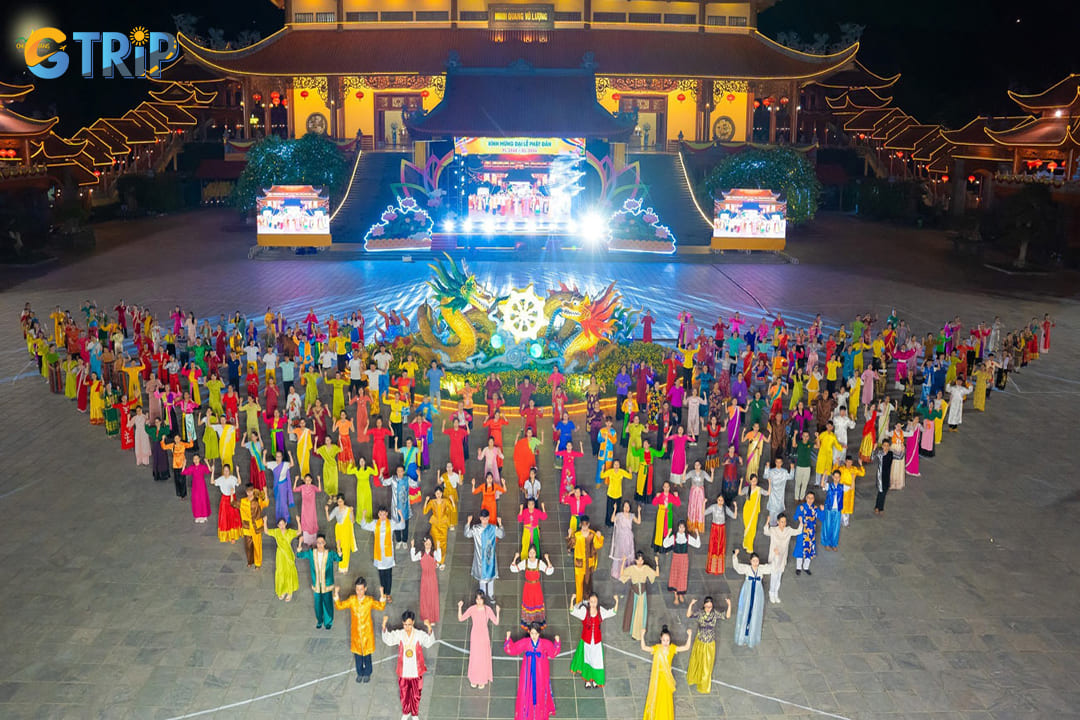
Visit the pagoda in the festive season to enjoy the vibrant atmosphere of the pagoda
For a peaceful and quieter visit, consider going in March or October, just before or after major festivals. These months offer a pleasant climate and fewer crowds, allowing for a more intimate experience of the pagoda’s serene surroundings. Families with children or those seeking a quieter visit will find these months perfect for exploring the pagoda’s vast grounds and enjoying its serene atmosphere away from the peak festival crowds.
For nature lovers and photographers, February to April and September to November provide the best climate and natural beauty, with lush greenery and mild weather enhancing the landscape's charm. During these months, you can enjoy pleasant temperatures and clear skies, making it comfortable for hiking around the pagoda and nearby scenic spots like Bo De Mountain. With the balance of cultural festivals, peaceful months, and scenic beauty, Ba Vang Pagoda offers a rich experience throughout the year.
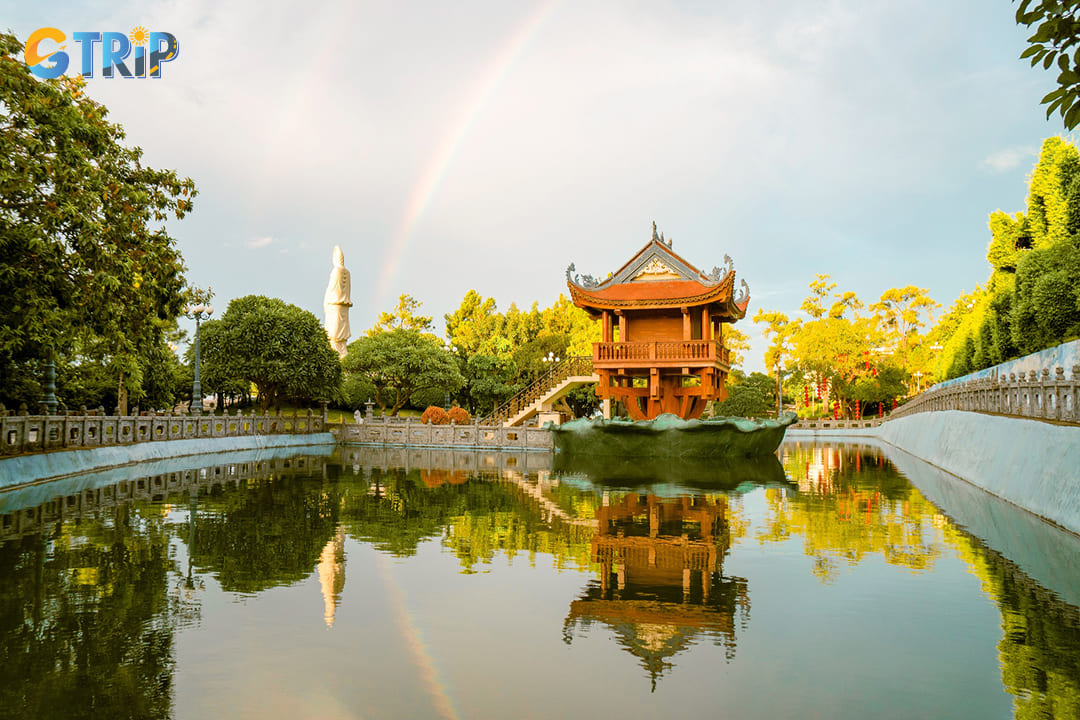
Visit the pagoda in peace to fully explore its beauty
How to get to Ba Vang Pagoda?
Getting to the pagoda is convenient from either Ha Long City or Hanoi, with multiple options available for each route to suit different budgets and preferences.
From Ha Long City (39 km away)
The journey from Ha Long City to Ba Vang Pagoda is around 39 kilometers and typically takes about 25-30 minutes by car or motorbike. Here are some recommended ways to make this trip:
- By car or motorbike: Driving is the most straightforward option. Simply follow the main road out of Ha Long City towards Uong Bi District, where the pagoda is located. This route offers flexibility, especially for those wanting to explore nearby attractions. Car and motorbike rentals are available in Ha Long, allowing for a quick, self-guided journey.
- By taxi: For convenience, a taxi is a quick and comfortable choice, with fares generally between 200,000 - 300,000 VND (approximately $8 - $12) one way. Taxis can be booked from Ha Long City center or through popular ride-hailing apps, providing direct access to the pagoda.
- By local bus: For budget travelers, there are local buses running from Ha Long City towards Uong Bi, stopping near the pagoda. The fare is affordable, typically between 10,000 - 20,000 VND. However, buses are less frequent, and the trip might be slower than by taxi or private vehicle.
From Hanoi (135 km away)
For travelers starting from Hanoi, the pagoda is around 135 kilometers away, with an approximate travel time of 2.5 to 3 hours by car. Here are some options:
- By car: Driving from Hanoi to the pagoda is convenient and allows for stops along the way. Take National Route 18 towards Quang Ninh Province, then follow signs to Uong Bi and Ba Vang Pagoda. This route passes through scenic countryside and provides a direct way to the pagoda, ideal for families or small groups.
- By bus: Numerous buses depart from Hanoi to Ha Long City, offering a more economical choice. Bus tickets range from 100,000 - 200,000 VND (about $4 - $8), depending on the service. From Ha Long City, you can take a taxi or local bus to reach the pagoda. Major bus companies offer comfortable seating, making it a viable option for budget-conscious travelers.
- By taxi: For those looking for a direct and comfortable ride, a taxi from Hanoi directly to Ba Vang Pagoda costs between 1,000,000 - 1,500,000 VND (approximately $40 - $60). This option offers a private, door-to-door service and is often available through various taxi services or ride-hailing apps.
Ba Vang Pagoda’s role in environmental conservation
The pagoda’s role in environmental conservation emphasizes harmony between spirituality and ecology. It fosters sustainable practices while preserving the natural beauty of Thanh Dang Mountain and the nearby Ha Long Bay ecosystem.
Eco-friendly design
The architecture and layout of the pagoda are deliberately designed to integrate with the mountainous environment. Designed to minimize environmental impact, the structures are positioned to preserve the landscape’s natural features, blending the mountain’s greenery seamlessly with the spiritual space. This careful integration reduces disruption to the local flora and fauna, while the mountain’s forests provide a serene atmosphere that enhances travelers’ spiritual experiences. The pagoda’s design encourages an appreciation for nature’s beauty, demonstrating how modern spiritual sites can coexist with their surrounding ecosystems.
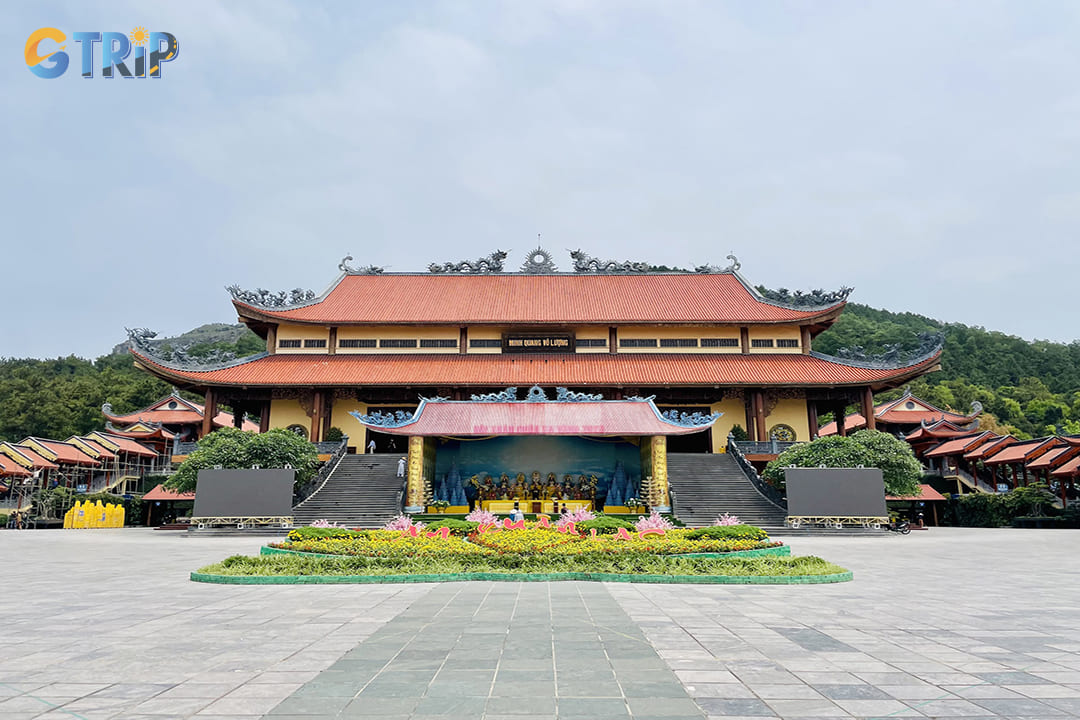
The eco-friendly design of Ba Vang integrates with the mountainous environment
Sustainable practices and ecological awareness
Ba Vang Pagoda is committed to sustainability through its management of green spaces, environmental cleanliness, and eco-friendly practices. Gardens and natural areas around the pagoda are maintained with care, creating a green sanctuary that serves as a model for ecological preservation. In addition, the pagoda actively promotes eco-conscious behavior among tourists by encouraging responsible disposal of waste and by minimizing the use of plastics. Educational programs, workshops, and signage reinforce the importance of environmental responsibility, linking these values to Buddhist teachings about compassion and respect for all living things. The pagoda’s initiatives emphasize that environmental stewardship is an essential aspect of spiritual practice.
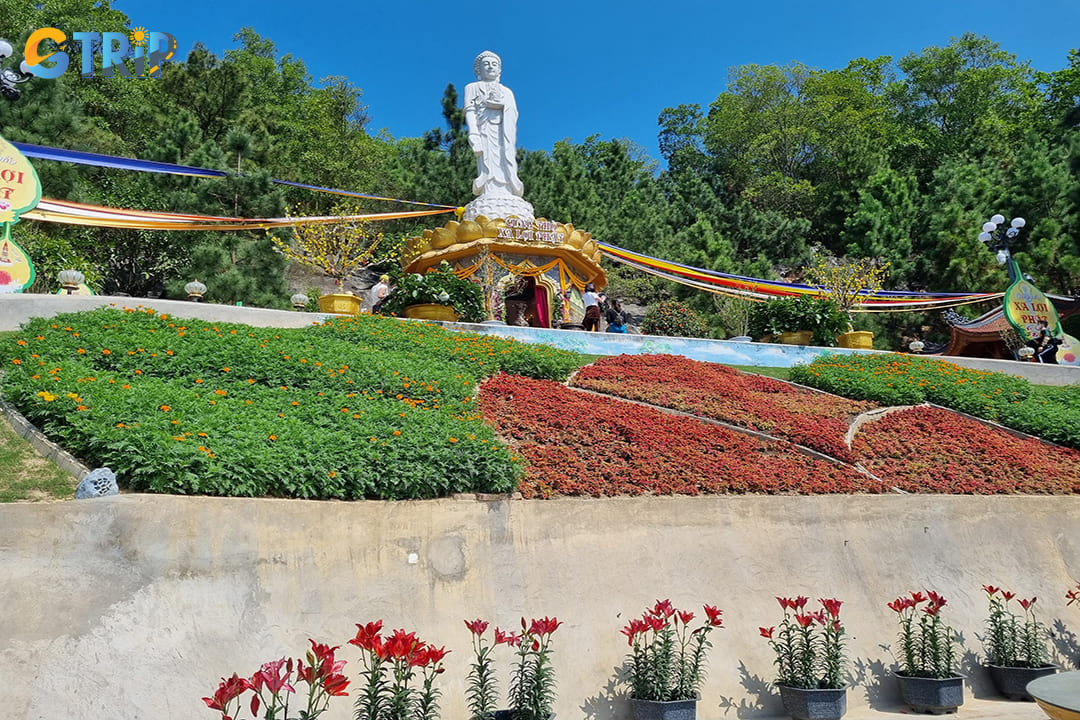
Green spaces, environmental cleanliness, and eco-friendly practices of the pagoda
Connection to Ha Long Bay’s ecosystem
Ba Vang Pagoda’s location near Ha Long Bay ties it to the conservation efforts within this renowned UNESCO World Heritage Site. By promoting responsible tourism and sustainable practices, the pagoda supports the protection of Ha Long Bay’s unique marine and terrestrial ecosystems. Its efforts encourage tourists to appreciate and protect the natural wonders of the region, advocating for respectful interaction with the environment. This connection supports a conservation mission across Quang Ninh Province, raising awareness about biodiversity protection and the balance of Vietnam’s natural landscapes.
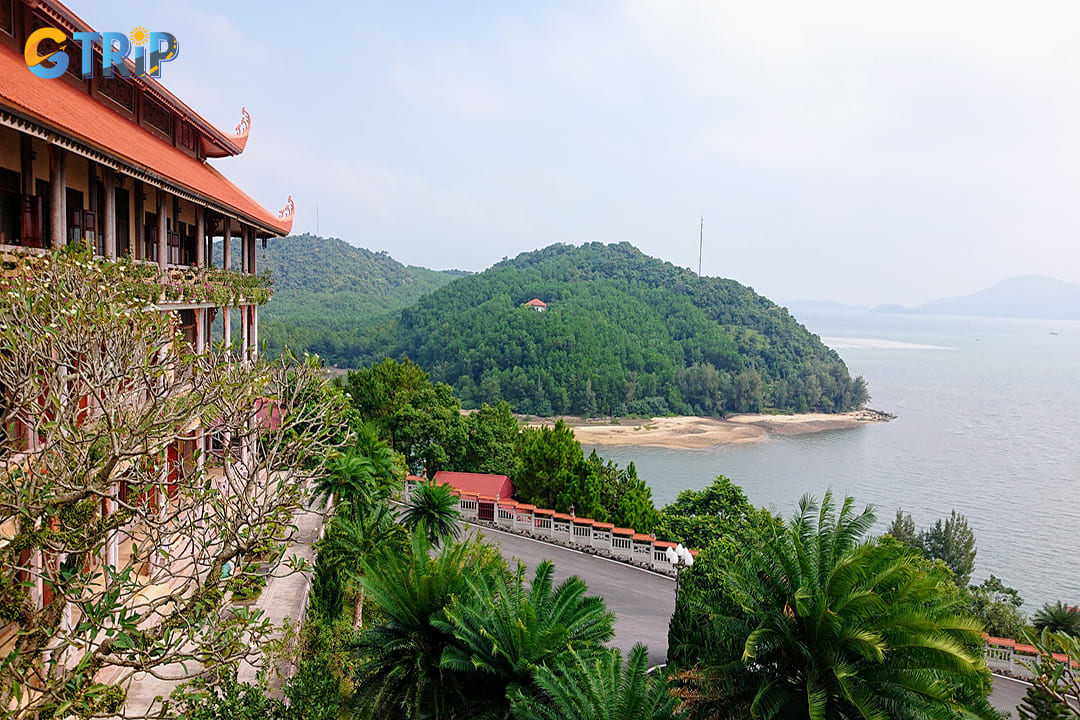
The pagoda ties it to the conservation efforts within the Ha Long Bay
Notes when visiting Ba Vang Pagoda
Following these guidelines will help you honor the pagoda’s spiritual and cultural traditions while enhancing your experience in this sacred space.
- Dress modestly: Wear clothing that covers your shoulders, knees, and back to respect the sacred environment and cultural norms of the pagoda.
- Respect the sacred environment: Avoid picking flowers or disturbing plants around the grounds, as they are part of the tranquil atmosphere.
- Limit personal belongings: You should bring only necessary items and avoid placing them on altars or in worship spaces, as these areas are reserved for spiritual practices.
- Keep distance from monks’ living quarters: Refrain from entering or disturbing areas designated for monks' personal use to respect their privacy.
- Avoid touching sacred instruments: Bells, drums, and other ceremonial items should only be used in ritual contexts. Do not handle these without permission.
- Maintain a quiet atmosphere: You should keep conversations low and avoid loud noises to honor the serene and peaceful setting of the pagoda.
- Dispose of waste responsibly: Tourists help keep the pagoda grounds clean by disposing of trash in designated areas and leaving no waste behind.
- Respect sacred objects: Avoid touching, moving, or taking any religious objects or decorations within the pagoda, as these are central to its sanctity.
We are GTrip - Vietnam Travel Agency, accompanying you on Vietnam tours

